History of Nature
A note on Nature’s archive
Nature’s archive comprises all the content published since the journal’s launch in 1869; it includes some images, articles and language that by twenty-first-century standards are offensive and harmful, including sexist, racist and other discriminatory content. This content does not represent Nature’s current values and would be unacceptable to publish today. We have not sought to suppress it because it is part of the scientific and historical record, and so should remain available for scholars now and in the future. Nature is committed to making the changes necessary to ensure that it learns from its past and creates a publication that champions science for everyone.
1860s
 The first issue of Nature was published on 4 November 1869. Many earlier publishing adventures in science had failed dismally, but Nature’s eventual success grew out of the social and scientific conditions under which it was founded — driven by the vision of strong personalities, who forged ahead when the odds seemed against them. Nature, above all, has been a survivor. This it owes to Alexander Macmillan, who tolerated a loss-making venture for three decades; to Norman Lockyer, the first editor; and to a string of influential collaborators and contributors, including biologist Thomas Henry Huxley — one of the heavyweights of Victorian science and a staunch ally of Charles Darwin (he was known as ‘Darwin’s bulldog’).
The first issue of Nature was published on 4 November 1869. Many earlier publishing adventures in science had failed dismally, but Nature’s eventual success grew out of the social and scientific conditions under which it was founded — driven by the vision of strong personalities, who forged ahead when the odds seemed against them. Nature, above all, has been a survivor. This it owes to Alexander Macmillan, who tolerated a loss-making venture for three decades; to Norman Lockyer, the first editor; and to a string of influential collaborators and contributors, including biologist Thomas Henry Huxley — one of the heavyweights of Victorian science and a staunch ally of Charles Darwin (he was known as ‘Darwin’s bulldog’).
Brothers Alexander and Daniel Macmillan founded their bookshop and publishing house in Cambridge, UK, in 1843. After Daniel’s death in 1857, Alexander opened a London branch at 23 Henrietta Street, Covent Garden. Macmillan’s headquarters were in Cambridge until 1863, when they moved to 16 Bedford Street in London. The academic standing of the Macmillans in Cambridge (their shop was at the heart of the university city) later helped Alexander to establish contacts with eminent men of science in London. He would host ‘tobacco parliaments’, at which science, art and hot topics of the day, such as Darwinism, would be discussed. This “talk, tobacco and tipple on Thursdays” group, as he described it, fostered friendships among the great scientific educators of the Victorian era, including Huxley and the physicist John Tyndall, who were eager to write for Macmillan. In 1859, Alexander launched Macmillan’s Magazine, the first shilling monthly in England, aiming to unify science, literature and the arts under one banner, with David Masson as the editor. Huxley’s article ‘Time & Life’ was published in the second issue.
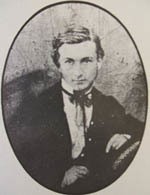 Lockyer (pictured) was born in Rugby in Warwickshire on 17 May 1836. A clerk in the UK government’s War Office, he was a keen and talented young amateur astronomer — he was later to co-discover the element helium in the corona of the Sun, using a spectroscope. Lockyer frequently shared a train carriage to London with publisher John Ludlow and author Thomas Hughes, both friends of Macmillan, and they asked him to be the science editor of their proposed weekly, The Reader, which was to cover the arts, literature and science. The Reader, launched in 1863, was in many ways an early forerunner to Nature — 38 people who supplied reviews to The Reader later contributed to Nature. Unfortunately for Lockyer, the paper was commercially disorganized and its poor financial performance meant that — like many publications in the Victorian era — it lasted for only a few years. Image source: Life and Work of Sir Norman Lockyer by T. Mary Lockyer and Winifred L. Lockyer (Macmillan, 1928).
Lockyer (pictured) was born in Rugby in Warwickshire on 17 May 1836. A clerk in the UK government’s War Office, he was a keen and talented young amateur astronomer — he was later to co-discover the element helium in the corona of the Sun, using a spectroscope. Lockyer frequently shared a train carriage to London with publisher John Ludlow and author Thomas Hughes, both friends of Macmillan, and they asked him to be the science editor of their proposed weekly, The Reader, which was to cover the arts, literature and science. The Reader, launched in 1863, was in many ways an early forerunner to Nature — 38 people who supplied reviews to The Reader later contributed to Nature. Unfortunately for Lockyer, the paper was commercially disorganized and its poor financial performance meant that — like many publications in the Victorian era — it lasted for only a few years. Image source: Life and Work of Sir Norman Lockyer by T. Mary Lockyer and Winifred L. Lockyer (Macmillan, 1928).
The exact time and place of Macmillan and Lockyer’s first meeting is not known, but the twin topics of science and publishing would have dominated their early conversations. With their shared interests and friends (including poet laureate Alfred Lord Tennyson), they soon became friends themselves, travelling to France together in 1867 after Lockyer’s second nervous breakdown (he had three, the first in 1864). Macmillan commissioned Lockyer to write a book about astronomy. Then, in 1868, he asked Lockyer to act as scientific adviser to his publishing house. This was lucky for Lockyer, because — despite his best efforts — The Reader had proved editorially and financially troublesome, and his career path at the War Office was uncertain.
Lockyer approached Macmillan in early 1869 with plans for a new scientific journal. Lockyer’s early career was at its zenith: he had co-discovered helium in 1868, which earned him election to the Royal Society the following year. Macmillan and Lockyer’s relationship was mutually beneficial: scientific publishing was prominent in Macmillan’s long-term publishing strategy and, if he were to undertake the risky venture of a new scientific journal, Lockyer was the man to take the helm. As botanist Joseph Hooker pointed out, the record of eminent men of science in publishing was “dismal”. However, Lockyer’s organizational and editorial skills on The Reader had attracted praise — for example, Hughes wrote to Huxley: “Lockyer ... knows the machinery ... has the science already in the right grooves, and is not above taking advice.” Competition loomed from the new science weeklies Popular Science Review and Scientific Opinion.
It’s not clear who proposed the title Nature, but a letter in July 1869 from Huxley to Lockyer reveals that Macmillan made the final decision: “Macmillan told me yesterday that he had nailed his colours to the mast — and was going in for ‘Nature’, pure and simple. I am inclined to think it is the best plan on the whole.” In a letter to Lockyer, the mathematician James Joseph Sylvester enthused wildly on the potential: “What a glorious title, Nature — a veritable stroke of genius to have hit upon. It is more than Cosmos, more than Universe. It includes the seen as well as the unseen, the possible as well as the actual. Nature and Nature’s God, mind and matter. I am lost in admiration of the effulgent blaze of ideas it calls forth.”
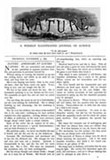 Early issues of Nature (pictured) included what today would be called a mission statement. “First, to place before the general public the grand results of scientific work and scientific discovery, and to urge the claims of science to a more general recognition in education and in daily life; and secondly, to aid scientific men themselves, by giving early information of all advances made in any branch of natural knowledge throughout the world.” The journal carries essentially the same message to this day. These bold assertions were not unique to Nature; the prospectuses of both Scientific Opinion and The Reader made similar rallying cries for men of science and lay people to have at their disposal a specialized organ for communicating science to scientists and the masses. You can access the first issue of Nature here.
Early issues of Nature (pictured) included what today would be called a mission statement. “First, to place before the general public the grand results of scientific work and scientific discovery, and to urge the claims of science to a more general recognition in education and in daily life; and secondly, to aid scientific men themselves, by giving early information of all advances made in any branch of natural knowledge throughout the world.” The journal carries essentially the same message to this day. These bold assertions were not unique to Nature; the prospectuses of both Scientific Opinion and The Reader made similar rallying cries for men of science and lay people to have at their disposal a specialized organ for communicating science to scientists and the masses. You can access the first issue of Nature here.
1870s
“I am very anxious about Nature. I cannot help feeling that a very little more of something would make it a success.” Macmillan’s 1871 letter to Lockyer reveals that, although Lockyer boasted of 5,000 subscribers and 15,000 readers in 1870 (a circulation in reality not attained even by the end of the century), the future of the fledgling Nature was by no means secure. Macmillan gave it a competitive cover price — at fourpence, it was less than the sixpence charged by most weeklies. Science historian Roy Macleod has estimated that the four pages per issue given over to advertisements in 1869–70 would have accounted for only half the annual costs of producing the magazine, and that there were in fact probably fewer than 200 subscribers in Nature’s first year. At least the potential rival weekly Scientific Opinion had ceased publication in 1870, but Nature was not yet established as a preferred place of scientific communication.
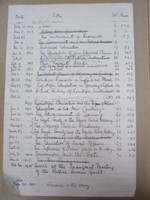 Lockyer wrote 66 editorials from 1869 to 1919; others were composed by subeditors working with a band of more than 100 contributors. Besides scientific articles on topics such as the HMS Challenger oceanic exploration mission, transits of Venus and eclipse expeditions, Nature campaigned hard on issues such as research endowments, scientific reform, the rise of German science and teaching in schools as the education acts laboured through the British government. By 1878, Lockyer seemed to be satisfied that, through Nature, awareness of the right questions was on the rise as a result of the growing space given to such matters by the daily press: “Questions concerning scientific discovery, research and teaching, have now a much more direct interest to the public than they formerly possessed.”
Lockyer wrote 66 editorials from 1869 to 1919; others were composed by subeditors working with a band of more than 100 contributors. Besides scientific articles on topics such as the HMS Challenger oceanic exploration mission, transits of Venus and eclipse expeditions, Nature campaigned hard on issues such as research endowments, scientific reform, the rise of German science and teaching in schools as the education acts laboured through the British government. By 1878, Lockyer seemed to be satisfied that, through Nature, awareness of the right questions was on the rise as a result of the growing space given to such matters by the daily press: “Questions concerning scientific discovery, research and teaching, have now a much more direct interest to the public than they formerly possessed.”
The 1870s were a decade of scientific advances, and the pages of Nature celebrated many of the most important, such as the inventions of the typewriter and bathometer, and included notes on the telephone, duplex telegraphy and the application of electricity to lighting. But early Nature also had a less technical readership, as evidenced by correspondence featuring readers’ observations on “ingenuity in a pigeon” and “a carnivorous goose”, as well as discussion of simple and amusing experiments.
Nature’s contributors were usually eminent men of science, often from the upper echelons of Victorian society, but this did not preclude private squabbles from becoming public — indeed, Lockyer seems to have encouraged controversy in the pages of Nature. The year 1873 saw perhaps the most acrimonious exchange, between physicists Peter Guthrie Tait and John Tyndall. Tait’s critique of Tyndall’s pamphlet Principal Forbes and his Biographers led to bitter rivalries in the correspondence columns; these resurfaced with a review of Tyndall’s book The Forms of Water in Clouds and Rivers, Ice, and Glaciers, and spilled over into other journals, newspapers and pamphlets. It was a damaging affair, and Lockyer was privately chastised. Writing to T. H. Huxley, Tyndall bemoaned that: “My notions regarding him [Lockyer] have been too undisguised.” Writing about a different dispute, Joseph Hooker stated that: “My suspicions are strong against Lockyer, of whom I have heard much that I do not like.”
 Nature’s early international flavour might well have influenced a host of foreign rivals that appeared in the 1870s and bore the same name. In France, La Nature (pictured) was first published in 1873. Then came the Norwegian Naturen in 1877, also the year in which the Italian La Natura was launched — this even echoed the banner of its English counterpart with “Giornale Illustrato di Cognizioni” (‘illustrated newspaper of cognitions’). There was a Belgian Natura printed in Ghent from 1883 to 1885, and the Dutch geillustreerd maandschrift (‘illustrated monthly book’) Die Natur was published from 1881 to 1894. Beyond Europe, the Mexican La Naturaleza started a second edition in 1887.
Nature’s early international flavour might well have influenced a host of foreign rivals that appeared in the 1870s and bore the same name. In France, La Nature (pictured) was first published in 1873. Then came the Norwegian Naturen in 1877, also the year in which the Italian La Natura was launched — this even echoed the banner of its English counterpart with “Giornale Illustrato di Cognizioni” (‘illustrated newspaper of cognitions’). There was a Belgian Natura printed in Ghent from 1883 to 1885, and the Dutch geillustreerd maandschrift (‘illustrated monthly book’) Die Natur was published from 1881 to 1894. Beyond Europe, the Mexican La Naturaleza started a second edition in 1887.
Throughout his life, Lockyer experienced nervous exhaustion and bouts of depression. In March 1877, he had his third breakdown, probably due to the pressures of his professional commitments and exacerbated by caring for his ill wife and son. Lockyer’s physician recommended to a Macmillan employee that he should spend some time abroad to recuperate. Alexander Macmillan obliged with a cheque and a note that: “The firm desires your acceptance of it with the love of all the members.” Again, we see Macmillan’s affection and solicitude in taking great care of his editor. Lockyer recovered, but his son Frank died in 1878, and Lockyer’s wife, Winifred, died the next year, leaving Lockyer to care for their seven remaining children.
 The journal had been making a loss since the first issue, but only after almost ten years did Alexander Macmillan raise the price from fourpence to sixpence, expanding it to 28 pages. Lockyer opened “what is practically a New Series of Nature” with a bold editorial: “it is because Nature has become more and more widely recognised as the organ of science all the world over that at last we are compelled to enlarge it in order to find space for the stream of communications that week after week come pouring in upon us from all parts.” Picture shows Macmillan’s letter to Lockyer in 1869, detailing 24 pages at fourpence per issue as “quite high enough [a] price”.
The journal had been making a loss since the first issue, but only after almost ten years did Alexander Macmillan raise the price from fourpence to sixpence, expanding it to 28 pages. Lockyer opened “what is practically a New Series of Nature” with a bold editorial: “it is because Nature has become more and more widely recognised as the organ of science all the world over that at last we are compelled to enlarge it in order to find space for the stream of communications that week after week come pouring in upon us from all parts.” Picture shows Macmillan’s letter to Lockyer in 1869, detailing 24 pages at fourpence per issue as “quite high enough [a] price”.
1880s
Nature editorials in the 1880s expanded on the strongly political topics of the 1870s and were directed to the politicians of the day with increasing conviction. The 1880 Elementary Education Act made school attendance compulsory for all children in England and Wales up to the age of ten. A few months before it passed, Nature appealed to William Harcourt — who would become British home secretary that year — to make the teaching of science a priority in schools: “Those who have the true welfare of our country at heart will use every means to get education in science introduced into all our schools and colleges ... so that in future years rulers and people will be guided ... by the principles of scientific statesmanship.” Other editorials urged a scientific approach to management of the state.
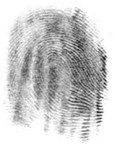 The short letter of 28 October 1880 by Henry Faulds entitled ‘On the Skin-furrows of the Hand’ was perhaps one of the earliest significant and original contributions to science published in Nature: “When bloody finger-marks or impressions on clay, glass &c., exist, they may lead to the scientific identification of criminals.” Fingerprint patterns (pictured) were described scientifically in 1823, but Faulds was the first to detail how “skin-furrows” could be used in identification, ethnography, studies of heredity and medical–legal investigations — essentially sketching out the basis of what was to become forensic science. Just a month later, William Hershel (grandson of the discoverer of Uranus) published a letter in Nature claiming previous use of the identification technique in India: “I have been taking sign-manuals by means of finger-marks for now more than twenty years.” Argument raged between the two, with statistician Francis Galton weighing in, but Faulds’s letter clearly documents the advantages of having “a nature-copy of the for-ever-unchangeable finger-furrows of important criminals”.
The short letter of 28 October 1880 by Henry Faulds entitled ‘On the Skin-furrows of the Hand’ was perhaps one of the earliest significant and original contributions to science published in Nature: “When bloody finger-marks or impressions on clay, glass &c., exist, they may lead to the scientific identification of criminals.” Fingerprint patterns (pictured) were described scientifically in 1823, but Faulds was the first to detail how “skin-furrows” could be used in identification, ethnography, studies of heredity and medical–legal investigations — essentially sketching out the basis of what was to become forensic science. Just a month later, William Hershel (grandson of the discoverer of Uranus) published a letter in Nature claiming previous use of the identification technique in India: “I have been taking sign-manuals by means of finger-marks for now more than twenty years.” Argument raged between the two, with statistician Francis Galton weighing in, but Faulds’s letter clearly documents the advantages of having “a nature-copy of the for-ever-unchangeable finger-furrows of important criminals”.
The 1880s were a time of career milestones for Lockyer. In the late 1870s, he had been appointed head of the Solar Physics Observatory in South Kensington, London, a post that awarded him £500 in research expenses. Following this, in 1881, Lockyer was made a lecturer at the nearby Normal School of Science (later to become the Royal College of Science, and then part of Imperial College) and awarded a salary of £750 per year. He was made professor of astronomical physics in 1887. Friendships bloomed with notable figures from outside science, including Alfred Lord Tennyson. Tennyson, who was particularly interested in astronomy, later wrote a note to Lockyer: “In my anthropological spectrum, you are coloured like a first rate star of science.” In 1910, Lockyer wrote a book called Tennyson as a Student and Poet of Nature.
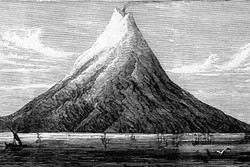
Early Nature carried a strong international flavour and covered science from around the globe. Following the cataclysmic eruption of the volcano Krakatau (pictured) in what is now Indonesia on 26–27 August 1883, Nature appealed to its worldwide audience to send observations that would be forwarded to the Royal Society Krakatoa Committee.
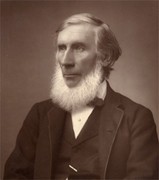
For most of the nineteenth century, there was very little in the way of a career structure in science in Britain. There were few universities, and therefore few professional posts to fill, and scholars concentrated on classic subjects, such as ancient Greek, rather than science. But by the late 1880s, enough had changed for Nature to proclaim that the scientific movement had at last been truly born, thanks to the part played by great scientific educators of the day such as John Tyndall (pictured). An editorial celebrating his achievements declared of the English people: “It has been no easy task to convince them that a new era — that of science — was dawning ... that our industrial position can only be maintained if armies of well-equipped followers are ready to seize the ground which the leaders win.”
1890s
In the 1890s, Nature saw many events that consolidated its position as an increasingly successful scientific publication. At last, it was breaking into profit. The journal pressed on with its editorial campaigns on education, following with utmost scrutiny the implementation of the British Technical Instruction Act and supporting a single University of London on the grounds that “a duplication of Universities in London would be a misfortune of the first magnitude, dividing resources and diverting energies into channels that would lead to many undesirable results”. Overall, the 1890s were to be celebrated: the journal had survived for 25 years and attracted high-quality submissions. These included work that foreshadowed the discovery of the electron and powered flight, and a four-page exclusive on X-rays. Lockyer’s influence grew and, although he lost favour with some scientists, a former laboratory assistant — and future editor — joined the team.
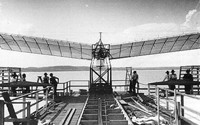 An article in the Nature issue of 23 July 1891, entitled ‘Experimental Researches on Mechanical Flight’, was supplied by US physicist Samuel P. Langley, based on an address he had given to the Paris Academy of Sciences earlier that month. More than ten years before the brothers Orville and Wilbur Wright made their famous flight — the first controlled, sustained flight in a powered, heavier-than-air craft — the author modestly provided experimental proof that wings or blades could generate sufficient lift by altering the angle of inclined planes over streams of air. Image shows an early aeroplane, courtesy of NASA.
An article in the Nature issue of 23 July 1891, entitled ‘Experimental Researches on Mechanical Flight’, was supplied by US physicist Samuel P. Langley, based on an address he had given to the Paris Academy of Sciences earlier that month. More than ten years before the brothers Orville and Wilbur Wright made their famous flight — the first controlled, sustained flight in a powered, heavier-than-air craft — the author modestly provided experimental proof that wings or blades could generate sufficient lift by altering the angle of inclined planes over streams of air. Image shows an early aeroplane, courtesy of NASA.
In 1889, the Technical Instruction Act had come into force, setting out how science should be taught in schools. Nature kept a close eye on its implementation, lamenting in an editorial in February 1890 that — “great advance as it was on its predecessors — [it] fell a victim to the fears of one party and the lukewarmness of another”. Nature continued to address the politics of education: in the same article, it mocked the “so-called ‘educationists’ (a newly introduced word with an ominous ring to it)” for not tackling the core issue of how the few precious years of education should best be utilized. But an editorial in April 1890 gave praise to attempts to “link the instruction of the school to the life in the home”, and another on the education fees debate set out the journal’s stall in June 1891: “We want a free road kept open to the University.”
 Richard Arman Gregory (pictured) joined Nature in 1893 as an assistant editor, after a brief stint as Lockyer’s assistant at his South Kensington laboratory. The early 1890s were the only time when Gregory was an active researcher: his work was mainly routine, measuring the positions and spectra of sunspots and solar prominences, and he does not appear as co-author on any published papers of original research during his time at South Kensington. Nevertheless, Gregory was a skilled astronomer and teacher, and he resigned from the laboratory in 1893 to pursue work as a journalist and lecturer; he had already taken the post of extension lecturer at the University of Oxford, which he occupied from 1890 to 1895. Lockyer saw in Gregory a man of sharp intellect, and duly recommended to Alexander Macmillan his appointment as assistant editor. Gregory later became an editor for Macmillan’s science books, and oversaw the publication of more than 200 titles until his retirement in 1938.
Richard Arman Gregory (pictured) joined Nature in 1893 as an assistant editor, after a brief stint as Lockyer’s assistant at his South Kensington laboratory. The early 1890s were the only time when Gregory was an active researcher: his work was mainly routine, measuring the positions and spectra of sunspots and solar prominences, and he does not appear as co-author on any published papers of original research during his time at South Kensington. Nevertheless, Gregory was a skilled astronomer and teacher, and he resigned from the laboratory in 1893 to pursue work as a journalist and lecturer; he had already taken the post of extension lecturer at the University of Oxford, which he occupied from 1890 to 1895. Lockyer saw in Gregory a man of sharp intellect, and duly recommended to Alexander Macmillan his appointment as assistant editor. Gregory later became an editor for Macmillan’s science books, and oversaw the publication of more than 200 titles until his retirement in 1938.
In November 1894, Nature celebrated its 25th anniversary with a splendid dinner at the Savoy Hotel in London, attended by George Macmillan, son of Alexander, and Frederick and Maurice Macmillan, sons of Daniel Macmillan. T. H. Huxley led the toasts: “Better to be an architect building a house under the dual control of a husband and wife ... than an editor.” Huxley also contributed to the anniversary issue, including a hint of self-mockery at his own choice of opening article in the very first issue, a translation of the rhapsody ‘Die Natur’ by Goethe, which he doubted would have been understood by “more than half-a-dozen of the readers”.
Archive sources reveal how, more than 25 years after its first issue, Nature was beginning to command a position as the preferred place for researchers to reveal their findings. William Crookes, an English physicist and chemist who had discovered the element thallium in 1861, sent an account of the spectrum of helium to Lockyer in 1895, soon after Scottish chemist William Ramsey had isolated the gas terrestrially (27 years after Lockyer had detected it in the Sun’s corona). Crookes’s letter reveals how Nature had a higher standing than its weekly competitor Chemical News, which Crookes had founded in 1859: “It will appear in the Chemical News on Friday, but my circulation is not to the same class of researchers as that of ‘Nature’, and having taken a great deal of trouble about it I want the results to get to the right people.”
Nature was at last attracting serious scientific papers. On 23 January 1896, the journal carried the first description of X-rays in English, in two lavish articles spread over four pages, including three photographs. The first article was written by the rays’ discoverer, Wilhelm Röntgen. The second is an early forerunner of today’s News & Views section — a brief commentary by a different author on the same subject, to add context to the discovery.
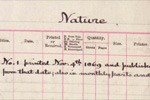 At the close of the nineteenth century — three decades after the journal’s launch — Macmillan’s ledgers finally showed that Nature was no longer making a loss. George Craik, Macmillan’s ‘chancellor of the exchequer’, wrote to Lockyer: “I am glad that your diligence and tenacity has been at last rewarded by money besides all the honour that Nature has brought you. We have waited many years.” The last line is particularly poignant, because Alexander Macmillan, the man who had founded and stood by the journal, had retired in the early 1890s; it is to him that Nature owes its position today. Lockyer — who was knighted in 1897 — made the magazine a success in scientific terms, but without the patience and deep pockets of the publisher, Nature would not exist.
At the close of the nineteenth century — three decades after the journal’s launch — Macmillan’s ledgers finally showed that Nature was no longer making a loss. George Craik, Macmillan’s ‘chancellor of the exchequer’, wrote to Lockyer: “I am glad that your diligence and tenacity has been at last rewarded by money besides all the honour that Nature has brought you. We have waited many years.” The last line is particularly poignant, because Alexander Macmillan, the man who had founded and stood by the journal, had retired in the early 1890s; it is to him that Nature owes its position today. Lockyer — who was knighted in 1897 — made the magazine a success in scientific terms, but without the patience and deep pockets of the publisher, Nature would not exist.
1900s
The editorial ‘The New Century’ heralds an era in which electricity and the “space-annihilating power” of mechanics have made Earth a “tiny satellite”, whereby an idea can be spread “as soon as it has emerged from the brain of the Thinker”. Indeed, true powered flight and the basis for television would arrive during this decade. However, there was little in the way of real celebration in the new century’s editorials. Britain’s global power and influence were in decline, and its industrial power was waning by comparison with that of Germany and the United States. More resources for education, closer ties between science and industry, and the application of the scientific method to government were consistent themes of Nature’s prescribed medicine for the ills of the British Empire: “The attempts to put our house in order will be made on scientific lines.”
Lockyer resigned from the Royal College of Science in 1902, remarried in 1903 and was elected president of the British Association for the Advancement of Science the same year. In his inaugural address to the association, he pointed out that the Royal Navy had received £21.5 million for a five-year building programme in 1888. By contrast, British universities received £156,000 per year between them in the early 1900s — a paltry amount when compared with, for example, the equivalent of £169,000 allocated to the University of Berlin alone by the German government a decade earlier. Lockyer’s address, widely commented upon and quoted in speeches and in the press, was published as a pamphlet by Macmillan, titled On the Influence of Brain-Power on History. An editorial on similar lines in Nature noted: “It may be long in this slow-moving country before the influence of Brain-power on history is recognised as fully as the influence of Sea-power ... but undoubtedly it will be bad for our future if much more time is lost.”
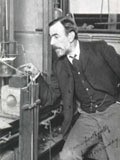
Chemists William Ramsay (pictured) and Frederick Soddy reported in the 13 August 1903 issue of Nature that helium gas is produced by the radioactive decay of radium. Working at University College London, they had unknowingly discovered the spontaneous transmutation of elements, but candidly offered no explanation for the effect: “The spectrum [of helium] was apparently a new one, probably that of the emanation, but this has not yet been completely examined, and we hope to publish further details shortly.” The spectrum was that of a previously unrecognized isotope of helium, but it would be another ten years before Soddy coined the term ‘isotope’ in the pages of Nature. He would go on to win the 1921 Nobel Prize in Chemistry for his work on radioactive elements and isotopes.
Following enthusiastic reviews of scientific lectures for women in previous decades, Nature continued with its then forward-looking attitude towards the role of women in science in a book review in 1904. Eleanor Anne Ormerod was an entomologist who applied her skills to agriculture and helped to found the field of economic entomology. The review of her biography throws much praise on her abilities, comparing her to pioneering astronomer Caroline Herschel and mathematician Mary Somerville, and hints that her work might have influenced London’s Linnean Society to open its doors to women — papers submitted by women were previously read to a male-only audience. Sadly, much as Ormerod’s achievements are lauded, the same cannot be said for the book, which Nature summarizes as “one the most glaring instances we have ever seen (and we have seen sufficiently bad ones before) of how not to edit a biography”.
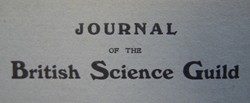 By 1905, Nature had espoused the importance of science education and lobbied for the application of the scientific method to government for decades. The British Science Guild was launched to formalize such activities, and Lockyer was a principal instigator. The 12 October 1905 issue of Nature carried news of the first meeting of the guild, which would push for “making the scientific spirit a national characteristic which shall inspire progress and determine the policy in affairs of all kinds”. The organization was associated with no political party and its membership was open to men and women. Lockyer took the position of chair of the committees, because many members were Nature contributors and many others were close friends, including Joseph Hooker, geologist Archibald Geikie, Alfred Lord Tennyson and zoologist Ray Lankester. Lockyer’s wife, Mary, was honorary assistant treasurer.
By 1905, Nature had espoused the importance of science education and lobbied for the application of the scientific method to government for decades. The British Science Guild was launched to formalize such activities, and Lockyer was a principal instigator. The 12 October 1905 issue of Nature carried news of the first meeting of the guild, which would push for “making the scientific spirit a national characteristic which shall inspire progress and determine the policy in affairs of all kinds”. The organization was associated with no political party and its membership was open to men and women. Lockyer took the position of chair of the committees, because many members were Nature contributors and many others were close friends, including Joseph Hooker, geologist Archibald Geikie, Alfred Lord Tennyson and zoologist Ray Lankester. Lockyer’s wife, Mary, was honorary assistant treasurer.
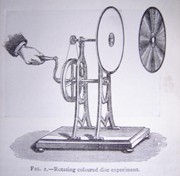 The development of the telegraph in the previous century had been a revelation. Now, the race was on to transmit images. Alexander Graham Bell’s photophone and Shelford Bidwell’s ‘Tele-photography’ had demonstrated that the transmission of live images was possible, but an article by Bidwell published on 4 June 1908 emphasized the “wildly impracticable” problems of synchronizing 160,000 mechanical operations per second to transmit an image just two inches square. Within two weeks, a reply from Scottish electrical engineer Alan Archibald Campbell-Swinton sketched out the solution with unnerving accuracy: “The problem of obtaining distant electric vision can probably be solved by employment of two beams of kathode rays (one at the transmitting and one at the receiving station)” (see image). The letter goes on to detail how electromagnets would direct the beam over a wide surface, and even that “a sufficiently sensitive fluorescent screen” would be needed to “obtain the desired result”.
The development of the telegraph in the previous century had been a revelation. Now, the race was on to transmit images. Alexander Graham Bell’s photophone and Shelford Bidwell’s ‘Tele-photography’ had demonstrated that the transmission of live images was possible, but an article by Bidwell published on 4 June 1908 emphasized the “wildly impracticable” problems of synchronizing 160,000 mechanical operations per second to transmit an image just two inches square. Within two weeks, a reply from Scottish electrical engineer Alan Archibald Campbell-Swinton sketched out the solution with unnerving accuracy: “The problem of obtaining distant electric vision can probably be solved by employment of two beams of kathode rays (one at the transmitting and one at the receiving station)” (see image). The letter goes on to detail how electromagnets would direct the beam over a wide surface, and even that “a sufficiently sensitive fluorescent screen” would be needed to “obtain the desired result”.
By the end of the 1900s, the structure of the magazine still had not significantly changed since the first issue in 1869. The tendency in the 1880s for leading articles to consist of book reviews, and non- or semi-scientific ones at that, continued into the new century, and the Our Book Shelf section seemed to grow, often at the expense of the scientific correspondence of the Letters section. The end of the journal was little changed — Articles, Notes, Our Astronomical Column, Societies and Academies were all still present — save for the addition of a column, University and Educational Intelligence, detailing appointments at learned institutions. The Diary section common in the 1870s made a comeback as Diary of Societies; as before, it listed lectures and talks worthy of attendance.
1910s
The 1910s were a decade of change and upheaval for much of the world and, with its broad international reach and perspective, the journal, too, endured difficult years. The First World War changed the social, political and scientific landscape of Europe. As countries and economies adapted to war, the flow of submissions from around the globe inevitably slowed, and Nature’s subscriptions fell for the first time. The journal was also faced with the challenge of adapting to the new prevailing perception of Germany as an enemy. Previously, the country’s achievements in science, particularly chemistry, had been hailed as models of successful modern organization. After the war, the journal had to acknowledge science’s role in the bloodshed, a task for Richard Gregory who, having been editor in all but name for years, officially took over the editorship the day after Nature’s 50th anniversary, in 1919.
The outbreak of war, in 1914, brought an about-turn in the sentiment of Nature editorials towards all things Teutonic. German science, and particularly its model marriage with industry, had once been applauded, but in ‘The War – and after’ in September 1914, Nature declared melodramatically: “We are back in the days of the Huns.” The rhetoric gathered pace in William Ramsay’s 8 October editorial, which accused the Germans of wanting “world supremacy for their race” and, in terms of science, of the “exploitation of the inventions and discoveries of others”, suggesting that Germans brought a spirit of unfairness and untrustworthiness. Ramsay even accused the German army of barbarism. In a strange nod to happier times, he then called for English scientists to keep the degrees and awards conferred on them by the “older race of German men of science”, in opposition to the German practice of returning such distinctions.
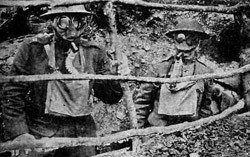 On 22 April 1915, the German Army used a lethal asphyxiating gas for the first time at the second battle of Ypres, on the Western Front. Amid the public outrage, there was considerable doubt as to the exact gas used. One Sunday newspaper surmised that it was carbon monoxide but, in an article just one week after the attack, Nature doubted that this gas would be effective, being lighter than air. A combination of scientific detective work and eyewitness reports led Nature to name chlorine, correctly, as a possible agent — the other it suggested was sulfur dioxide. The article asked two key questions: “how sufficient quantities were produced” and how such an agent could be managed so that it “should have no deleterious effects on those using it”. The alliance of science and industry in Germany was the answer to the first question. The second had no easy answer, as thousands of casualties on both sides later found.
On 22 April 1915, the German Army used a lethal asphyxiating gas for the first time at the second battle of Ypres, on the Western Front. Amid the public outrage, there was considerable doubt as to the exact gas used. One Sunday newspaper surmised that it was carbon monoxide but, in an article just one week after the attack, Nature doubted that this gas would be effective, being lighter than air. A combination of scientific detective work and eyewitness reports led Nature to name chlorine, correctly, as a possible agent — the other it suggested was sulfur dioxide. The article asked two key questions: “how sufficient quantities were produced” and how such an agent could be managed so that it “should have no deleterious effects on those using it”. The alliance of science and industry in Germany was the answer to the first question. The second had no easy answer, as thousands of casualties on both sides later found.
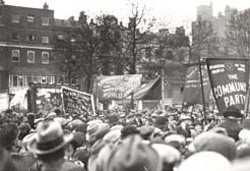 Content on industry and social issues increased fivefold between 1915 and 1919. Even before the war had finished, the issue of reconstruction was being touched on. A book review on 7 November 1918, for example, opened with: “‘Reconstruction’, like Mesopotamia, is a blessed word.” An editorial three weeks later boldly heralded a stronger social orientation in the journal’s editorial perspective: “The future, in fact, rests with labour, and it is upon the sanity and prudence of the workers and their employers that everything depends.” The Russian revolution had brought communism to an industrial power, and a new antagonism between capital and labour hovered ominously over the peace. Nature clearly sided with the labour movement.
Content on industry and social issues increased fivefold between 1915 and 1919. Even before the war had finished, the issue of reconstruction was being touched on. A book review on 7 November 1918, for example, opened with: “‘Reconstruction’, like Mesopotamia, is a blessed word.” An editorial three weeks later boldly heralded a stronger social orientation in the journal’s editorial perspective: “The future, in fact, rests with labour, and it is upon the sanity and prudence of the workers and their employers that everything depends.” The Russian revolution had brought communism to an industrial power, and a new antagonism between capital and labour hovered ominously over the peace. Nature clearly sided with the labour movement.
In letters from 1918 held at the British Library, Lockyer — then aged 82 and looking towards retirement — wrote to Frederick Macmillan about Gregory, saying how “satisfied I have been with what he has done for us in these troubled times”. Moreover, Lockyer then dismissed the idea that the new editor had to be a scientist distinguished enough to be a fellow of the Royal Society: “Fellows of the Royal Society are very difficult to lead, and very few of them have the slightest idea of administrative work or possess business capacity.” He clearly favoured Gregory, and made it clear to Macmillan that “I do not think we could do better than entrust the work to him even though he is not a Fellow.” Gregory had been de facto editor since Lockyer had left London in 1912 for a new observatory in Sidmouth, Devon, but assumed the role officially in November 1919. He was given a knighthood the same year, for organizing exhibitions of scientific products in 1918 and 1919, and was made a fellow of the Royal Society in 1933.
1920s
As Britain and many parts of the world emerged from the First World War, economic depression set in a number of industrialized countries and workers demanded more rights, pushing social issues to the fore. These would dominate the thinking of Nature’s new editor, Richard Gregory, as he forged a more modern, forward-looking journal. Under Gregory, the journal published editorials on social issues every week, not just occasionally, and he culled the vast list of leader writers to a hand-picked few. He was not afraid to embrace new ideas; unfortunately, theories of eugenics — then fashionable, now recognized as reprehensible — were among them. However, articles also continued to discuss traditional issues of science education, reform and state involvement, as well as the campaign to recognize science journalism as a profession. The magazine was bolstered by major discoveries in physics, such as the explanation for α-particle decay and the experimental confirmation of the phenomenon of thermal noise, and an entire special issue was devoted to Albert Einstein’s theory of relativity.
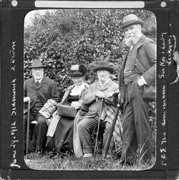 Norman Lockyer died on 16 August 1920, aged 84, leaving four sons and two daughters from his first marriage. His contributions to science, science education at schools and universities, scientific reform and science communication are almost immeasurable. He advanced the study of the Sun by many years, provided inspiration for the Science Museum in London, and developed science journalism — without him, it is doubtful whether Nature would exist in the form it does today (or at all). His hard work, determination, creative flair and commercial savvy, crossed with his characteristic bloody-mindedness, made the journal a success and it won him many friends and more than a few enemies over the years. He was a truly great and unforgettable giant of science (see Nature’s Obituary for more). In the year that he died, a future (joint) editor, agronomist Arthur J. V. Gale, joined Nature. In contrast to Lockyer, very little is known about him.
Norman Lockyer died on 16 August 1920, aged 84, leaving four sons and two daughters from his first marriage. His contributions to science, science education at schools and universities, scientific reform and science communication are almost immeasurable. He advanced the study of the Sun by many years, provided inspiration for the Science Museum in London, and developed science journalism — without him, it is doubtful whether Nature would exist in the form it does today (or at all). His hard work, determination, creative flair and commercial savvy, crossed with his characteristic bloody-mindedness, made the journal a success and it won him many friends and more than a few enemies over the years. He was a truly great and unforgettable giant of science (see Nature’s Obituary for more). In the year that he died, a future (joint) editor, agronomist Arthur J. V. Gale, joined Nature. In contrast to Lockyer, very little is known about him.
Although Gregory had been at the helm of Nature for more than a decade, the end of the First World War and Lockyer’s passing gave him a free hand to bring Nature into the post-war era. There were significant changes to the magazine and it is under Gregory that Nature began to evolve in the direction of its current form. Editorials had often been book reviews under Lockyer, but from 1919 Gregory instigated comment on a major social or scientific issue every week. He continued Lockyer’s passion for education, but the social and political issues of science were the subjects through which his zeal and passion for science as a curative agent for society’s ills would flow. To this end, he trimmed the hundreds of leader writers of Lockyer’s era to tens, with just 4 men writing 17% of the editorials of the 1920s.
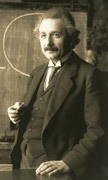 One of the many changes to the maturing journal in the 1920s includes what may have been the first-ever special issue. Almost every page of the 17 February 1921 edition is devoted to Einstein’s theory of relativity, and the introduction to the issue notes the interest of the theory for general readers — “as all thinking people have pondered over the metaphysics of infinity and eternity” — and announces that a very large sum of US$5,000 has been awarded by Scientific American for the clearest account yet of the theory. Einstein (pictured in 1921) states in his own (translated) article that there is “something attractive in presenting the evolution of a sequence of ideas in as brief a form as possible”, but this is perhaps overly optimistic for general readers, considering the complexity of what follows his claim that “the whole ascent is composed of small, almost self-evident steps of thought”. However, a series of short articles accompanies Einstein’s piece and serves to simplify and decode the complex theories, much as Nature’s ‘News & Views’ section would from the 1960s onwards.
One of the many changes to the maturing journal in the 1920s includes what may have been the first-ever special issue. Almost every page of the 17 February 1921 edition is devoted to Einstein’s theory of relativity, and the introduction to the issue notes the interest of the theory for general readers — “as all thinking people have pondered over the metaphysics of infinity and eternity” — and announces that a very large sum of US$5,000 has been awarded by Scientific American for the clearest account yet of the theory. Einstein (pictured in 1921) states in his own (translated) article that there is “something attractive in presenting the evolution of a sequence of ideas in as brief a form as possible”, but this is perhaps overly optimistic for general readers, considering the complexity of what follows his claim that “the whole ascent is composed of small, almost self-evident steps of thought”. However, a series of short articles accompanies Einstein’s piece and serves to simplify and decode the complex theories, much as Nature’s ‘News & Views’ section would from the 1960s onwards.
Lockyer took science journalism seriously, and his sense of a good story was one of his strengths. As editor of Nature, Gregory did much to continue promoting the idea of science journalism. In an address to the Association of Special Libraries and Information Bureaux, Gregory complained that there was little in the way of science journalism in newspapers, and that their staff were ill-qualified to write about science. He drew the association’s attention to the Science Service (now the Society for Science & the Public), a non-profit organization founded in the United States in 1921 by newspaper proprietor Edward W. Scripps. Taking this as his example, Gregory went on to found a science news service run by the British Science Guild in 1924, an early forerunner to the Association of British Science Writers.
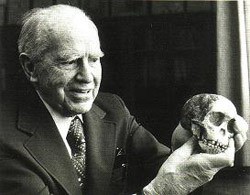 Australopithecus africanus, the “man-ape” of South Africa, described in 1925 in a paper by Raymond Dart (pictured), caused a sensation on publication, and placed Nature on the world stage before a popular audience. Until now, Nature’s scoops had been mostly in physics — the discovery of electrons, radioactivity, isotopes, X-rays — but here was an author contending that humans had originated in Africa, “thus vindicating the Darwinian claim that Africa would prove to be the cradle of mankind”. Many disagreed with Dart’s findings and preferred the prevailing view that humanity had originated in Eurasia, but this was the first time that fossil evidence from Africa had been presented, and Dart was correct in predicting that much more would follow: “In Southern Africa ... we may confidently anticipate many complementary discoveries concerning this period in our evolution.”
Australopithecus africanus, the “man-ape” of South Africa, described in 1925 in a paper by Raymond Dart (pictured), caused a sensation on publication, and placed Nature on the world stage before a popular audience. Until now, Nature’s scoops had been mostly in physics — the discovery of electrons, radioactivity, isotopes, X-rays — but here was an author contending that humans had originated in Africa, “thus vindicating the Darwinian claim that Africa would prove to be the cradle of mankind”. Many disagreed with Dart’s findings and preferred the prevailing view that humanity had originated in Eurasia, but this was the first time that fossil evidence from Africa had been presented, and Dart was correct in predicting that much more would follow: “In Southern Africa ... we may confidently anticipate many complementary discoveries concerning this period in our evolution.”
 In 1927, two papers arrived in the Nature offices that would advance understanding of physics at the quantum level and lead to inventions such as the electron microscope. The first, by Clinton Davisson and Lester Germer (pictured), is a fine example of how discovery is often catalysed by accident: in 1925, a bottle of liquefied air exploded in the laboratory where the authors were bombarding nickel with electrons to investigate its structure. The glass tube containing the nickel cracked, and the target became oxidized. After the nickel was processed to remove the oxide, the angular distribution of the reflected electrons changed. Further experiments revealed that the pattern of the electrons was determined by the crystal structure of the nickel target, not the intrinsic atomic structure of nickel. Comparison with the energies of X-rays striking the same target indicated that the electrons were behaving as waves, not particles. Just two months later, Alexander Reid and George Thomson (son of electron discoverer J. J. Thomson) published a paper that confirmed the finding by diffraction, rather than reflection. Davisson and Thomson duly shared the 1937 Nobel Prize in Physics.
In 1927, two papers arrived in the Nature offices that would advance understanding of physics at the quantum level and lead to inventions such as the electron microscope. The first, by Clinton Davisson and Lester Germer (pictured), is a fine example of how discovery is often catalysed by accident: in 1925, a bottle of liquefied air exploded in the laboratory where the authors were bombarding nickel with electrons to investigate its structure. The glass tube containing the nickel cracked, and the target became oxidized. After the nickel was processed to remove the oxide, the angular distribution of the reflected electrons changed. Further experiments revealed that the pattern of the electrons was determined by the crystal structure of the nickel target, not the intrinsic atomic structure of nickel. Comparison with the energies of X-rays striking the same target indicated that the electrons were behaving as waves, not particles. Just two months later, Alexander Reid and George Thomson (son of electron discoverer J. J. Thomson) published a paper that confirmed the finding by diffraction, rather than reflection. Davisson and Thomson duly shared the 1937 Nobel Prize in Physics.
1930s
By the 1930s, Richard Gregory had been at the helm for more than ten years and the magazine, building on changes made during the previous decade, began to approach its modern incarnation. Editorials continued to press for greater social justice and to appeal for a more prominent position for science in society. In this period, Nature would be declared “perhaps the most important weekly printed in English”, and it would be banned from Nazi Germany. The 1930s also saw the arrival of a future editor, and the editorial reins handed over again, this time to the only shared editorship. Discoveries continued to flow in from the golden age of physics as the secrets of the atom and the theory of atomic power were revealed.
 “These phenomena, like all others, demand an ultimate exposition of the truth.” This innocuous passage from a 22 March 1930 review in Nature of the book Growth and Trophic Movements of Plants by Jagadis Chandra Bose caught Gregory’s eye: it shared his vision of science as the search for a deep connection with the absolute truth. The review’s 26-year-old author, Lionel John Farnham Brimble (pictured) — Jack to his friends — was duly asked to join the Nature team as an assistant editor in 1931. Like Gregory, Brimble had earlier passed over a career in research to be an educator and communicator of science, and he flourished in the Nature office. In the late 1930s, he actively pushed for schools to teach biology, particularly his speciality of botany, which was previously taught only to girls in Britain.
“These phenomena, like all others, demand an ultimate exposition of the truth.” This innocuous passage from a 22 March 1930 review in Nature of the book Growth and Trophic Movements of Plants by Jagadis Chandra Bose caught Gregory’s eye: it shared his vision of science as the search for a deep connection with the absolute truth. The review’s 26-year-old author, Lionel John Farnham Brimble (pictured) — Jack to his friends — was duly asked to join the Nature team as an assistant editor in 1931. Like Gregory, Brimble had earlier passed over a career in research to be an educator and communicator of science, and he flourished in the Nature office. In the late 1930s, he actively pushed for schools to teach biology, particularly his speciality of botany, which was previously taught only to girls in Britain.
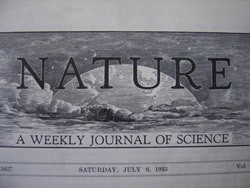 The intense weekly editorials championing scientific progress and pioneering social awareness reached a zenith in this decade, according to writer Arnold Bennett, who declared in London’s Evening Standard: “I regard Nature as perhaps the most important weekly printed in English, far more important than any political weekly” — even if he did go on to say that “the writing of it is considerably inferior to the matter of it”. The Notes section was renamed News and Views, but it still contained much the same mix of informal news and lightly opinionated content, and was very different from what it would later become. A reorganization led to a new double-page section, Research Items, which detailed research in other journals; its legacy lives to this day as the Research Highlights section of Nature. The number of Letters to the Editor expanded to double figures, and supplements continued to thrive, including History in the Archives of the Royal Society, a reprint of a lecture by crystallographer William Bragg. By the end of the decade, the journal had around 40 pages and a much crisper masthead (pictured).
The intense weekly editorials championing scientific progress and pioneering social awareness reached a zenith in this decade, according to writer Arnold Bennett, who declared in London’s Evening Standard: “I regard Nature as perhaps the most important weekly printed in English, far more important than any political weekly” — even if he did go on to say that “the writing of it is considerably inferior to the matter of it”. The Notes section was renamed News and Views, but it still contained much the same mix of informal news and lightly opinionated content, and was very different from what it would later become. A reorganization led to a new double-page section, Research Items, which detailed research in other journals; its legacy lives to this day as the Research Highlights section of Nature. The number of Letters to the Editor expanded to double figures, and supplements continued to thrive, including History in the Archives of the Royal Society, a reprint of a lecture by crystallographer William Bragg. By the end of the decade, the journal had around 40 pages and a much crisper masthead (pictured).
The British Science Guild and the British Association for the Advancement of Science had always been two different trains travelling on the same tracks and stopping at similar stations. In 1936, the inevitable happened and the organizations merged: Gregory became leader of a new Division for Social and International Relations of Science, and a journal, The Advancement of Science, replaced the guild’s annual report.
From 1933, Jewish academics — and, later, non-Jewish ones with Jewish spouses — were expelled from their jobs in Nazi Germany. Nature, in editorials such as ‘Freedom of the Mind’ in June 1937 and ‘Freedom of Science and Learning’ the next month, followed the exodus, or “German disaster”, with assertive fervour — “German men of science have been made subservient to the engineers of a ruthless political machine” — and championed the cause of 228 émigré scholars who had made their way to Britain. Nature was described in a German magazine as the “abominable Jewish journal”, and German science minister Bernhard Rust declared in November 1937 that “this journal must be expelled from general use in scientific libraries”.
In 1939, with war approaching, Gregory — who was nearing his 75th birthday — resigned. The Nature editorship was handed over to Arthur Gale and Jack Brimble. Between them, they had clocked up more than 25 years at Nature, and they took up a joint editorship that was to last for more than 20 years. It is widely agreed that under Gregory the journal had become an international institution. Subscriptions increased, and the Letters to the Editor section matured into the eminent vehicle for scientific communication that Nature’s founders had envisaged more than 50 years before. Charming but idiosyncratic novelties, such as readers’ reports of their pets’ behaviour and scientific poetry (including some from great scientists), made way for a more focused and professional publication. Nature was intent on changing not just science, but also Britain and the world, by means of a unique blend of up-to-date scientific correspondence and strong journalism that was socially aware but aimed to be politically unbiased.
“Once more the burden of war is laid upon us” begins the editorial of 9 September 1939, on the outbreak of the Second World War. Nature strikes to the ideological heart of the conflict: “It is not merely political liberty that is at stake ... it is the spirit of man.” The journal’s conscience had tussled with the angst of science as a weapon of war before; in 1937, it had declared: “In the time of the Great War the prostitution of science to warfare was deeply felt by British men of science ... the activity in rearmament is renewing ... the same problems of conscience.” Nature had supported the Moral Rearmament movement that sought to strengthen morality alongside the military, but highlighted “the lag which exists between the progress of scientific investigation and the ethical advance of mankind”. In its editorial at the start of the war, the journal urged that the knowledge and energies of those with scientific training “must be directed without remission to the service of the Allied cause”, not for “destruction, but a constructive ideal”.
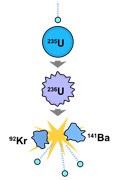 The discovery of uranium fission — and the prospect of atomic weaponry — came on the eve of war, after decades of discovery in the physical sciences. In 1932, John Cockcroft and Ernest Walton split the atom using the first apparatus for artificially accelerating atomic particles to high energies: the Cockcroft–Walton accelerator, which earned the pair the 1951 Nobel Prize in Physics. In the same year, James Chadwick discovered the neutron, and in 1934, Leo Szilard and Thomas Chalmers observed the emission of neutrons from a beryllium target bombarded with γ-rays; months later, they observed the same with X-rays. This effect indicated the potential for neutron chain reactions in radioactive elements to release immense quantities of energy. This was confirmed in 1939, when — after Otto Hahn and Fritz Strassmann observed it experimentally — Lise Meitner and Otto Frisch proposed a process whereby addition of a neutron could split the uranium nucleus. They called it fission, as in the division of living cells. Hahn alone was awarded the 1944 Nobel Prize in Chemistry, on which Nature Correspondence reveals more.
The discovery of uranium fission — and the prospect of atomic weaponry — came on the eve of war, after decades of discovery in the physical sciences. In 1932, John Cockcroft and Ernest Walton split the atom using the first apparatus for artificially accelerating atomic particles to high energies: the Cockcroft–Walton accelerator, which earned the pair the 1951 Nobel Prize in Physics. In the same year, James Chadwick discovered the neutron, and in 1934, Leo Szilard and Thomas Chalmers observed the emission of neutrons from a beryllium target bombarded with γ-rays; months later, they observed the same with X-rays. This effect indicated the potential for neutron chain reactions in radioactive elements to release immense quantities of energy. This was confirmed in 1939, when — after Otto Hahn and Fritz Strassmann observed it experimentally — Lise Meitner and Otto Frisch proposed a process whereby addition of a neutron could split the uranium nucleus. They called it fission, as in the division of living cells. Hahn alone was awarded the 1944 Nobel Prize in Chemistry, on which Nature Correspondence reveals more.
1940s
The Second World War dominated Britain in the 1940s, and it is difficult to glean much about the history of Nature from this period. With Arthur Gale and Jack Brimble sharing the editorship, the magazine kept running throughout the war, remained mercifully unscathed during the London Blitz and was distributed around the world as before — albeit with delays. The masthead was redesigned and, as in the preceding decades, the journal published many significant papers in the physical sciences. The first half of the twentieth century had heralded what many consider to be the golden age of physics, which was maintained with many new discoveries and technical advances in the 1940s, and ushered in the development of atomic weapons and their demonstration in 1945.
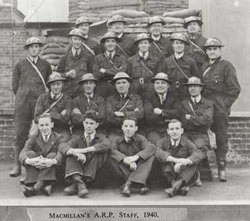 Wartime, particularly the Blitz, transformed London. Like Britain as a whole, the magazine carried on as well as it could, with a cavalier attitude towards what it described as the “occasional interruption of work caused by the proximity of delayed-action bombs”, as if it were all part of a day’s work. Readers were reassured that there was a contingency plan: “Arrangements have been in existence for some considerable time for Nature to carry on elsewhere in the unhappy event of its present home being uninhabitable for any length of time.” During the war, Brimble became involved in army education and lectured to various commands, as did Richard Gregory in the First World War, and penned the occasional editorial on the subject. Brimble organized the local firewatch (the Macmillan air-raid precaution staff are pictured) and received a wound during the Blitz that compromised his health in the years after the war.
Wartime, particularly the Blitz, transformed London. Like Britain as a whole, the magazine carried on as well as it could, with a cavalier attitude towards what it described as the “occasional interruption of work caused by the proximity of delayed-action bombs”, as if it were all part of a day’s work. Readers were reassured that there was a contingency plan: “Arrangements have been in existence for some considerable time for Nature to carry on elsewhere in the unhappy event of its present home being uninhabitable for any length of time.” During the war, Brimble became involved in army education and lectured to various commands, as did Richard Gregory in the First World War, and penned the occasional editorial on the subject. Brimble organized the local firewatch (the Macmillan air-raid precaution staff are pictured) and received a wound during the Blitz that compromised his health in the years after the war.
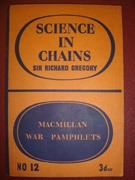 Throughout the Second World War, Macmillan produced a series of war pamphlets. In 1941, Nature described Gregory’s contribution to the series, ‘Science in Chains’ (pictured), in which he refrained from demonizing the enemy or its efforts, but hit back at the Nazi regime for banning Nature in 1937, and lamented that the discovery of truth by German scientists was seen “only through the veil of Nazi doctrine”. He quoted T. H. Huxley, who said that “science commits suicide when it adopts a creed”.
Throughout the Second World War, Macmillan produced a series of war pamphlets. In 1941, Nature described Gregory’s contribution to the series, ‘Science in Chains’ (pictured), in which he refrained from demonizing the enemy or its efforts, but hit back at the Nazi regime for banning Nature in 1937, and lamented that the discovery of truth by German scientists was seen “only through the veil of Nazi doctrine”. He quoted T. H. Huxley, who said that “science commits suicide when it adopts a creed”.
In the 1930s and 1940s, Nature published many influential papers by leading physicists: not only the classic paper by Lise Meitner and Otto Frisch that described uranium fission, but others including a string of papers by Hans von Halban, Frédéric Joliot and Lew Kowarski, who in 1939 established the possibility of nuclear chain reactions and nuclear energy production. During the war, James Chadwick forwarded work by von Halban and Kowarski — including detailed plans for nuclear reactors and how to make plutonium from uranium — to the Royal Society in sealed papers, which remained hidden, and forgotten, until 2007. A later editor, John Maddox, has suggested that these papers were submitted to Nature in the early 1940s, but that the UK government suppressed the publication of any research that could help Germany and the Axis powers to develop atomic weapons.
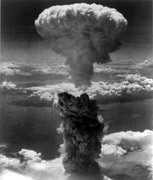 It fell to Gale to pen Nature’s editorials in the issues following the nuclear destruction of the Japanese cities of Hiroshima and Nagasaki in 1945. Apparently, these were the only two leading articles he ever wrote for Nature. In the first, on 11 August, he wrestled, just as Gregory had after the First World War, with the concept of science as an agent of death: “Some of the ablest scientific brains have been devoted for a period of years to the production of an engine of destruction.” He reprised Winston Churchill’s words on the new energy “long mercifully withheld from man”, and called for atomic technologies to be harnessed in peace time “to the needs of industry”. Gale went on to suggest that the lay public, not politicians, must direct governments on how to use such power responsibly (although he backtracked a little in the 18 August editorial). With the United Nations recently born, he said, the choice was “an international brotherhood of nations or chaos”.
It fell to Gale to pen Nature’s editorials in the issues following the nuclear destruction of the Japanese cities of Hiroshima and Nagasaki in 1945. Apparently, these were the only two leading articles he ever wrote for Nature. In the first, on 11 August, he wrestled, just as Gregory had after the First World War, with the concept of science as an agent of death: “Some of the ablest scientific brains have been devoted for a period of years to the production of an engine of destruction.” He reprised Winston Churchill’s words on the new energy “long mercifully withheld from man”, and called for atomic technologies to be harnessed in peace time “to the needs of industry”. Gale went on to suggest that the lay public, not politicians, must direct governments on how to use such power responsibly (although he backtracked a little in the 18 August editorial). With the United Nations recently born, he said, the choice was “an international brotherhood of nations or chaos”.
In 1947, Gregory was involved in the creation of the Association of British Science Writers (ABSW), and he remained founding president until his death. Nature had been complaining ever since the time of Norman Lockyer that there was too little in the way of serious science journalism in the popular press, and that most journalists were not qualified to write about science. The ABSW started with the intention of fixing this situation, and is still campaigning to improve standards of science journalism to this day. Lockyer and Gregory would be proud, although perhaps more than a little disappointed that the battle has not yet been won.
The existence of the subatomic particles called mesons had been predicted in 1935 in theoretical work by the Japanese physicist Hideki Yukawa, who had suggested that they were among the carriers of the strong nuclear force. In 1947, Cecil Powell and Giuseppe Occhialini reported the observation of star-like patterns in photographic emulsions exposed to cosmic rays on mountains at high altitude. Analysis of the particle tracks provided physical evidence for the proposed particle: “In view of the evidence ... we believe that the particles producing the observed disintegrations are negative mesons.” The existence of mesons was later confirmed when they were created artificially at the Berkeley cyclotron at the University of California. Yukawa received the 1949 Nobel Prize in Physics for his prediction of mesons, and Powell was awarded the 1950 prize for developing the technique of particle detection using photographic emulsions.
1950s
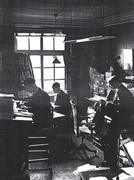 The decade after the Second World War was one of growth and consolidation. Subscriptions increased after a wartime fall and the magazine expanded its editorial page count to about 40. This was necessary in part to accommodate the burgeoning Letters section, which expanded considerably as the joint editorship of Arthur Gale and Jack Brimble steered a slightly revamped magazine through the post-war technological developments of the 1950s. In terms of scientific advances, it was biology’s turn to take centre stage from physics (although many discoveries were made using applications of physics, such as X-ray crystallography). The revelations of the structure of DNA and then the first structure of a protein, myoglobin, heralded the beginning of the golden age of biology — which even now may have reached only its adolescence. Image shows Nature offices in St Martin’s Street, London, in the 1950s; from the archives of Macmillan Publishers.
The decade after the Second World War was one of growth and consolidation. Subscriptions increased after a wartime fall and the magazine expanded its editorial page count to about 40. This was necessary in part to accommodate the burgeoning Letters section, which expanded considerably as the joint editorship of Arthur Gale and Jack Brimble steered a slightly revamped magazine through the post-war technological developments of the 1950s. In terms of scientific advances, it was biology’s turn to take centre stage from physics (although many discoveries were made using applications of physics, such as X-ray crystallography). The revelations of the structure of DNA and then the first structure of a protein, myoglobin, heralded the beginning of the golden age of biology — which even now may have reached only its adolescence. Image shows Nature offices in St Martin’s Street, London, in the 1950s; from the archives of Macmillan Publishers.
Richard Gregory remained a keen advocate of science after he relinquished the Nature editorship, holding a seven-year presidency of the British Association for the Advancement of Science. He died in 1952, aged 88, in Middleton-on-Sea, West Sussex, where he had retired. His activity in promoting the cause of science was unparalleled, perhaps even to this day. Involved with more than 70 societies, he was president of 25 and vice-president of 12. But his legacy lives on through his books and through Nature, because it was Gregory who took Norman Lockyer’s Victorian journal into the modern era and made it an international institution. Gregory wrote his own epitaph: “My grandfather preached the gospel of Christ, my father preached the gospel of socialism, I preach the gospel of science; but the ethical principles of all three are pursuit of truth and righteousness for the improvement of man and society.”
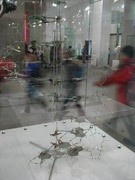
After more than 60 years, the double-helix structure of DNA has achieved iconic status, and not only in biology and science: it is recognizable the world over as a symbol of knowledge, discovery, life and more. James Watson and Francis Crick’s famous paper ‘A structure for deoxyribose nucleic acid’ was not reviewed by any other scientists before publication in 1953 — there was no way such a story could have been kept secret. John Maddox has suggested that Brimble would have talked to the head of the Cavendish Laboratory at the University of Cambridge, where the work was completed. In fact, it is said that modern Nature’s much more rigorous refereeing standards would mean that the paper, as a merely speculative piece of work, would not have been accepted today! Although not immediately or widely accepted as correct, it was — and the rest, including Watson and Crick’s receipt of the 1962 Nobel Prize in Physiology or Medicine, is history. Image shows reconstruction of Crick’s original DNA model at the Science Museum.
Although Nature had been going for decades, the journal had no formal system for reviewing papers for publication. Since the days of Lockyer, articles might be sent to eminent scientists for their opinion, but the inconsistency of such an approach was storing up problems for the future, as the volume of submissions increased. Brimble was something of a man about town and evolved his own method of peer review. He would, according to Maddox, stuff his pockets with papers submitted to Nature and take them with him to the exclusive Athenæum Club on Pall Mall in London, just around the corner from the Royal Society. He would then quiz scientific members of the club on the merits of particular manuscripts, over luncheon or coffee. It was an imperfect system with many flaws, but the beginning of a review system nevertheless. It has also been said that Brimble might have decided to rely more on editorial assessment after Nature rejected two or three papers that later turned out to be important, on the advice of referees.
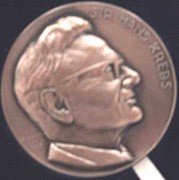 One such historic paper was biochemist Hans Krebs’s article of 1937 on the metabolic citric acid cycle, now usually called the Krebs cycle. A request from Nature for advice on a manuscript sent to Krebs’s team in 1953 shows that the journal did by then submit some papers for peer review, but the reply from Krebs was certainly more than Brimble would have bargained for: with tongue firmly in cheek, Krebs reminded the editors of Nature that the paper they had rejected back in 1937 was worthy of sharing the 1953 Nobel Prize in Physiology or Medicine. The letter then expressed “unreserved admiration for the anonymous editor who hid behind the distinguished initials RAG [Gregory], and who made Nature the great journal that it is”. Image, courtesy of the Federation of European Biochemical Societies, shows the Sir Hans Krebs Medal,which is awarded for outstanding achievements in biochemistry and related sciences.
One such historic paper was biochemist Hans Krebs’s article of 1937 on the metabolic citric acid cycle, now usually called the Krebs cycle. A request from Nature for advice on a manuscript sent to Krebs’s team in 1953 shows that the journal did by then submit some papers for peer review, but the reply from Krebs was certainly more than Brimble would have bargained for: with tongue firmly in cheek, Krebs reminded the editors of Nature that the paper they had rejected back in 1937 was worthy of sharing the 1953 Nobel Prize in Physiology or Medicine. The letter then expressed “unreserved admiration for the anonymous editor who hid behind the distinguished initials RAG [Gregory], and who made Nature the great journal that it is”. Image, courtesy of the Federation of European Biochemical Societies, shows the Sir Hans Krebs Medal,which is awarded for outstanding achievements in biochemistry and related sciences.
The Second World War had given way to the cold war and, as communism spread through Eastern Europe, there was a sharp drop in the number of papers received from the region. In 1953, Brimble was elected to the Royal Society of Edinburgh; in his inaugural address, he professed that no papers were arriving from the Soviet Union, and very few from its satellite states. This trend reversed in the early 1960s, a result of a policy to encourage submissions from the Eastern Bloc and emerging countries.
Editorials reflected the modern atomic age, and the use of nuclear power became a key issue. The 1955 ‘Nuclear Power and its Utilization’ makes note of US President Dwight Eisenhower’s plans for an international pool of nuclear fuel for peaceful use in power stations — a reasonable idea, and one that is still advocated in Nature editorials. Addressing domestic concerns in the same year, ‘Transport Policy in Great Britain’ urged haste in motorway-building plans and highlighted the role of scientists and technologists as public educators of transport policy. Again in 1955, ‘Social Implications of Automatic Control in Industry’ noted the rise of machines to replace manual labour in industry: “Full automation”, it declared, “does not yet exist, though it may be achieved in a suitable industry before the end of this century."
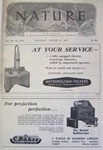 In the 1950s, the Letters section expanded beyond anything seen before in Nature. Swelled by the increasing volume of submissions from around the globe, it was not uncommon for issues to have 15–20 letters. Most were not refereed, were undated and were yet to include details on how the experiments were conducted. A single issue in August 1955 contains items on ‘Displacement Activities in Fiddler Crabs’, ‘Experimentally Induced Twinning in Plants’ and ‘Reverse-Shearing Interferometry’ — typical of the incredible variety of the burgeoning section. The Research Items double-page spread of news from other journals had made way for the enlarged Letters section, and all relics of the old back section — the Astronomical Column, Notes, Diary and Societies — had become history. Image of cover in the 1950s courtesy of the archives of Macmillan Publishers.
In the 1950s, the Letters section expanded beyond anything seen before in Nature. Swelled by the increasing volume of submissions from around the globe, it was not uncommon for issues to have 15–20 letters. Most were not refereed, were undated and were yet to include details on how the experiments were conducted. A single issue in August 1955 contains items on ‘Displacement Activities in Fiddler Crabs’, ‘Experimentally Induced Twinning in Plants’ and ‘Reverse-Shearing Interferometry’ — typical of the incredible variety of the burgeoning section. The Research Items double-page spread of news from other journals had made way for the enlarged Letters section, and all relics of the old back section — the Astronomical Column, Notes, Diary and Societies — had become history. Image of cover in the 1950s courtesy of the archives of Macmillan Publishers.
The structure of DNA had been a revelation, but the determination to uncover the first protein structure began the revolution that we now call proteomics. DNA is considered the blueprint of life, but proteins are much more complex. Their array of functions — for example, as signallers, structural components and catalysts to speed up reactions — means they are the molecules that make life actually happen. A large team, mostly physicists and led by John Kendrew at Cambridge, worked methodically to decipher the structure of myoglobin, the principal oxygen-carrying pigment in muscle, from a sperm whale (because it made a large crystal). As with DNA, X-ray crystallography — the measurement of the amplitude of thousands of X-rays scattered from the molecule — generated masses of data that revealed the structure piece by piece. Eventually, in 1958, the first high-resolution protein structure was revealed, including the never-before-seen α-helix structure. Kendrew shared the 1962 Nobel Prize in Chemistry with Max Perutz, who later deduced the structure of haemoglobin using the same technique.
It is perhaps surprising that the globe emblem that adorned the masthead of the first-ever issue survived until the late 1950s, albeit spruced up a little in the 1930s and 1940s. By the end of the decade, its swirling clouds, rustic font and rising globe were looking past their best and out of step with the post-war nuclear era. A new emblem from 1958 was simpler and starker, with a crisp and modern orange-and-white colour scheme, but a contrasting old-fashioned font. The masthead’s William Wordsworth quotation — “To the solid ground of Nature trusts the mind that builds for aye” — lasted until 1963.
1960s
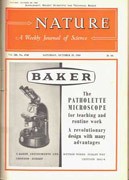 The swinging sixties were a decade of great change for Nature. Against a global backdrop of cultural shifts, the cold war and accelerating technological development, the magazine initially struggled to adapt to the changing times. The 1960s saw the retirement of one editor, the untimely death of another and the magazine rejuvenated in content, aesthetics and organization by a third. The journal was censored and archived, moved offices and received at least one proposal to buy it (although this was not taken seriously). Scientific advances continued apace: after publishing the structure of the protein haemoglobin, the magazine hosted the first structure of an enzyme, lysozyme, spurring on the biological revolution begun in the previous decade. In physics, the first laser — “a solution looking for a problem” — was developed by Theodore Maiman. The late 1960s also saw the discovery of pulsars, which were interpreted as possible extraterrestrial signals until their true nature as rotating neutron stars was deciphered.
The swinging sixties were a decade of great change for Nature. Against a global backdrop of cultural shifts, the cold war and accelerating technological development, the magazine initially struggled to adapt to the changing times. The 1960s saw the retirement of one editor, the untimely death of another and the magazine rejuvenated in content, aesthetics and organization by a third. The journal was censored and archived, moved offices and received at least one proposal to buy it (although this was not taken seriously). Scientific advances continued apace: after publishing the structure of the protein haemoglobin, the magazine hosted the first structure of an enzyme, lysozyme, spurring on the biological revolution begun in the previous decade. In physics, the first laser — “a solution looking for a problem” — was developed by Theodore Maiman. The late 1960s also saw the discovery of pulsars, which were interpreted as possible extraterrestrial signals until their true nature as rotating neutron stars was deciphered.
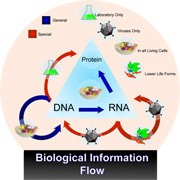 Solving the structure of DNA was the start of the golden age of biology, and ushered in an era when the blueprint for life was suddenly within grasp. But DNA’s structure did not reveal how it coded for proteins, until the seminal work ‘General Nature of the Genetic Code for Proteins’, by Francis Crick and his colleagues, answered at a stroke the crucial questions that cracked the DNA-to-protein code (modern schematic is shown). The authors showed that three DNA bases code for one amino acid; the code does not overlap; it has a fixed starting point; and different triplet combinations of base pairs can code for the same amino acid. The paper conveys the excitement that it was just a matter of time before more major advances would follow: “the coding problem is wide open for experimental attack ... the genetic code may well be solved within a year”. By 1966, the base-pair triplets (codons) for all 20 amino acids encoded in DNA had been identified, many in Crick’s Cambridge laboratory.
Solving the structure of DNA was the start of the golden age of biology, and ushered in an era when the blueprint for life was suddenly within grasp. But DNA’s structure did not reveal how it coded for proteins, until the seminal work ‘General Nature of the Genetic Code for Proteins’, by Francis Crick and his colleagues, answered at a stroke the crucial questions that cracked the DNA-to-protein code (modern schematic is shown). The authors showed that three DNA bases code for one amino acid; the code does not overlap; it has a fixed starting point; and different triplet combinations of base pairs can code for the same amino acid. The paper conveys the excitement that it was just a matter of time before more major advances would follow: “the coding problem is wide open for experimental attack ... the genetic code may well be solved within a year”. By 1966, the base-pair triplets (codons) for all 20 amino acids encoded in DNA had been identified, many in Crick’s Cambridge laboratory.
 Arthur Gale (pictured, right, with co-editor Jack Brimble) retired at the end of 1961, after having worked for Nature for more than 40 years. Only Richard Gregory had served in an active capacity for longer (1893–1939); Norman Lockyer was editor in name only for a little more than the last decade of his 50 serving years (1869–1919). Very little is known of Gale, who came across as silent and hard-working next to Brimble’s more ‘jet-propelled’ character. Theirs was apparently an eccentric system that worked only because Brimble was out of the office a great deal (frequently at lunch at the Athenæum, handing out papers for informal review — see 1950s). Upon Gale’s retirement, Brimble became sole editor. Image from archives of Macmillan Publishers.
Arthur Gale (pictured, right, with co-editor Jack Brimble) retired at the end of 1961, after having worked for Nature for more than 40 years. Only Richard Gregory had served in an active capacity for longer (1893–1939); Norman Lockyer was editor in name only for a little more than the last decade of his 50 serving years (1869–1919). Very little is known of Gale, who came across as silent and hard-working next to Brimble’s more ‘jet-propelled’ character. Theirs was apparently an eccentric system that worked only because Brimble was out of the office a great deal (frequently at lunch at the Athenæum, handing out papers for informal review — see 1950s). Upon Gale’s retirement, Brimble became sole editor. Image from archives of Macmillan Publishers.
As the Letters section in Nature grew, so did the proportion of contributions from countries around the world. The 1960s showed an increase in submissions from the Soviet Union and its satellite states, such as Poland and Hungary, after correspondence all but ceased in the 1950s. In 1962, East Germany published 4 Letters to West Germany’s 56. Nature was distributed to the communist Eastern Bloc, but was censored.
In 1964, Macmillan moved out of the offices in St Martin’s Street, London, that it had occupied since 1897, and took up space in Little Essex Street. By then, the company had accumulated a considerable archive of material related to publishing of books, which was sorted and deposited at the British Library. The archive was later added to, in 1990 and 2004. It includes some correspondence with Lockyer and other eminent scientists involved in establishing Nature in the nineteenth century, but only on the subject of book publication. Some early correspondence about Nature has survived in the personal archives of Lockyer, Gregory and other scientists. An attempt was made in the 1970s to store correspondence specifically relating to Nature at Imperial College London, but most of the material remained unsorted and was eventually destroyed.
 Before 1960, almost no one believed that the continents moved, but a series of papers in Nature changed how the world was viewed. As new rock forms, the direction of Earth’s magnetic field is imprinted in its ferrous elements. But the magnetic ‘stripes’ (pictured) that formed as the poles periodically reversed did not tally in rocks from different continents — so either the magnetic poles were wandering, or the sea floor was moving. Frederick Vine and Drum Matthews’s 7 September 1963 paper on sea-floor magnetism built on key observations made by others, such as Keith Runcorn and Robert Dietz a decade earlier. Although Vine and Matthews were not alone in suggesting that the sea floor was spreading, their paper was the first to reconcile an unpopular theory with direct palaeomagnetic evidence from sea-floor lava flows. In less than a decade, the idea of continental drift was accepted, and Earth science was born as a modern interdisciplinary subject. Image courtesy of the United States Geological Survey.
Before 1960, almost no one believed that the continents moved, but a series of papers in Nature changed how the world was viewed. As new rock forms, the direction of Earth’s magnetic field is imprinted in its ferrous elements. But the magnetic ‘stripes’ (pictured) that formed as the poles periodically reversed did not tally in rocks from different continents — so either the magnetic poles were wandering, or the sea floor was moving. Frederick Vine and Drum Matthews’s 7 September 1963 paper on sea-floor magnetism built on key observations made by others, such as Keith Runcorn and Robert Dietz a decade earlier. Although Vine and Matthews were not alone in suggesting that the sea floor was spreading, their paper was the first to reconcile an unpopular theory with direct palaeomagnetic evidence from sea-floor lava flows. In less than a decade, the idea of continental drift was accepted, and Earth science was born as a modern interdisciplinary subject. Image courtesy of the United States Geological Survey.
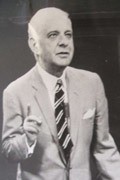 The shock and sadness felt by colleagues at Brimble’s sudden death at the age of 61 in his flat in London on 15 November 1965 is conveyed in the tone of the announcement in Nature that week. His obituary the following week conveys the passion he had for science throughout his life. Brimble (pictured) was devoted to the magazine and fought hard for its independence and integrity. Archive material held in Basingstoke shows that, despite his jovial manner, Brimble was not afraid to take on the house of Macmillan (then chaired by Daniel Macmillan’s grandson, Harold — the former British prime minister) if he felt that Nature’s core values were being eroded. Brimble lived long enough to mark the 5,000th issue of Nature in August 1965, when he was interviewed by the BBC and proudly asserted that 250,000 scientists read Nature in 120 countries, from a distribution of 15,000 copies. Image from the archives of Macmillan Publishers.
The shock and sadness felt by colleagues at Brimble’s sudden death at the age of 61 in his flat in London on 15 November 1965 is conveyed in the tone of the announcement in Nature that week. His obituary the following week conveys the passion he had for science throughout his life. Brimble (pictured) was devoted to the magazine and fought hard for its independence and integrity. Archive material held in Basingstoke shows that, despite his jovial manner, Brimble was not afraid to take on the house of Macmillan (then chaired by Daniel Macmillan’s grandson, Harold — the former British prime minister) if he felt that Nature’s core values were being eroded. Brimble lived long enough to mark the 5,000th issue of Nature in August 1965, when he was interviewed by the BBC and proudly asserted that 250,000 scientists read Nature in 120 countries, from a distribution of 15,000 copies. Image from the archives of Macmillan Publishers.
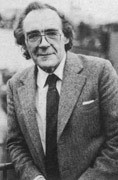 After Brimble’s death, it took six months to find a new editor. Macmillan News announced in June 1966 that the post would be taken by John Maddox (pictured), who had been a theoretical physicist, a lecturer at the University of Manchester, UK, and a journalist at The Manchester Guardian (later The Guardian) before becoming an administrator of the Nuffield Science Teaching Project, which sought to modernize UK science education for 5- to 18-year-olds. Maddox would draw heavily on his experience as scientist and journalist during his editorship. In his interview, he remarked that Nature “didn’t have much in the way of news” for a weekly. In fact, there was much about the journal that needed to change. More staff members were needed to tackle the massive backlog of submissions, and members of the scientific community had issues with the handling of manuscripts. The magazine needed an overhaul and required modernizing in many departments. Macmillan archive material shows that eminent scientists were sounded out about the magazine’s perceived failings.
After Brimble’s death, it took six months to find a new editor. Macmillan News announced in June 1966 that the post would be taken by John Maddox (pictured), who had been a theoretical physicist, a lecturer at the University of Manchester, UK, and a journalist at The Manchester Guardian (later The Guardian) before becoming an administrator of the Nuffield Science Teaching Project, which sought to modernize UK science education for 5- to 18-year-olds. Maddox would draw heavily on his experience as scientist and journalist during his editorship. In his interview, he remarked that Nature “didn’t have much in the way of news” for a weekly. In fact, there was much about the journal that needed to change. More staff members were needed to tackle the massive backlog of submissions, and members of the scientific community had issues with the handling of manuscripts. The magazine needed an overhaul and required modernizing in many departments. Macmillan archive material shows that eminent scientists were sounded out about the magazine’s perceived failings.
Maddox’s first job was to tackle the backlog of 2,300 unpublished manuscripts. Some scientists complained that during Brimble’s editorship, the choice of printworthy pieces seemed “arbitrary” and “not up to standard”, that “valuable material was missed” and that “Nature retains a very Victorian air”. The receipt date of manuscripts was not recorded. The 5,001st issue, in 1965, had 30 Letters to the Editor detailing scientific discoveries, in addition to two sections of Articles. Legend has it that Brimble’s system for tracking submitted papers was a particularly wide windowsill, with manuscripts piled high by month — a visible ‘histogram’ of how much had still to be done. The only solution was a comprehensive refereeing system, which also meant that the referees themselves had to be refereed. It was 18 months before the backlog of manuscripts was cleared.
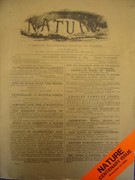 By the time Nature reached its centenary issue (pictured) in 1969, Maddox had begun to cast off the magazine’s antiquated air. The most significant introduction was a News section that actually treated news as something more significant than a mere announcement. This was promoted to the front of the journal to follow the editorials, which continued to address timely issues of the day, and was followed by a reborn News and Views section that decoded complex topics and brought back a readability that had been submerged by increasing specialization. Nature celebrated 100 years with a VIP dinner and a collection of brilliant historical articles, principally authored by Roy Macleod. The issue’s introduction, ‘Is it safe to look back?’ (almost certainly written by Maddox) flashes optimistically forward with the reflection: “At this occasion in the domestic history of Nature ... it remains an honest objective to win for science ... an opportunity to change the world.”
By the time Nature reached its centenary issue (pictured) in 1969, Maddox had begun to cast off the magazine’s antiquated air. The most significant introduction was a News section that actually treated news as something more significant than a mere announcement. This was promoted to the front of the journal to follow the editorials, which continued to address timely issues of the day, and was followed by a reborn News and Views section that decoded complex topics and brought back a readability that had been submerged by increasing specialization. Nature celebrated 100 years with a VIP dinner and a collection of brilliant historical articles, principally authored by Roy Macleod. The issue’s introduction, ‘Is it safe to look back?’ (almost certainly written by Maddox) flashes optimistically forward with the reflection: “At this occasion in the domestic history of Nature ... it remains an honest objective to win for science ... an opportunity to change the world.”
1970s
The 1970s was a decade of success and failure for Nature. In the early 1970s, the magazine ambitiously split into three publications, but the experiment did not last, perhaps too bold a move and ahead of its time. The magazine was reunited shortly after David ‘Dai’ Davies took on the sixth editorship in 1973, closing the first Maddox era. The Nature community was also saddened by the death of Arthur Gale, co-editor from 1939 to 1961, in 1978. Other activities brought more cheer. The magazine’s first base in the United States proved both a scientific and a commercial success, and manuscripts received from around the world led to at least three Nobel Prizes. In 1970, there were about 12 members of Nature staff, including production staff, of whom half were scientists. The London office had a quick sojourn in Canberra House in Maltravers Street, but by 1972 was back at Little Essex Street
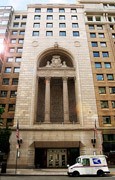 The beginning of the 1970s saw Nature expanding its global presence. Always an international journal, it set up its first US office in a small room (3 by 6 metres) in the National Press Building in Washington DC (pictured). The office was run for six months by John Maddox and his right-hand person, Mary Sheehan, and had the dual purpose of increasing Nature subscriptions in the United States and bolstering the flow of manuscripts from US laboratories. But the move undoubtedly increased awareness of the journal and perhaps even its influence. Nature was said in the 31 August issue of TIME magazine to have influenced the resignation of Lee DuBridge, President Richard Nixon’s science adviser (see ‘Whom Does the Science Adviser Advise?’ and ‘All Change at the Top’). After Maddox returned to the London office, the Washington DC office was run by deputy editor Nicholas Wade. Image courtesy of CaryScott.com.
The beginning of the 1970s saw Nature expanding its global presence. Always an international journal, it set up its first US office in a small room (3 by 6 metres) in the National Press Building in Washington DC (pictured). The office was run for six months by John Maddox and his right-hand person, Mary Sheehan, and had the dual purpose of increasing Nature subscriptions in the United States and bolstering the flow of manuscripts from US laboratories. But the move undoubtedly increased awareness of the journal and perhaps even its influence. Nature was said in the 31 August issue of TIME magazine to have influenced the resignation of Lee DuBridge, President Richard Nixon’s science adviser (see ‘Whom Does the Science Adviser Advise?’ and ‘All Change at the Top’). After Maddox returned to the London office, the Washington DC office was run by deputy editor Nicholas Wade. Image courtesy of CaryScott.com.
For just over ten years, Francis Crick’s ‘central dogma’ of molecular biology held that DNA made RNA, and RNA made protein, and that was how the information of life flowed in a cell. But there is always an exception in biology: RNA viruses spin RNA into DNA. The discovery of this process was a classic story of different researchers cracking the same problem at the same time — but by different means and each oblivious to the work of the others — and has led to major advances in molecular biology and drug development. Independently, Howard Temin and Satoshi Mizutani, and then David Baltimore, found the enzyme we now call reverse transcriptase in particles of tumour-forming viruses, rather than in the infected cell. Their papers were published in Nature in 1970; the accompanying News & Views article, ‘Central Dogma Reversed’ tells how “if ever there was a man in a position to say I told you so”, it was Temin, because he had advanced the idea in 1964 and been widely doubted, even ridiculed. Temin and Baltimore shared the 1975 Nobel Prize in Physiology or Medicine.
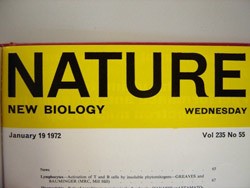 As the volume of scientific work produced around the world increased and became more specialized, it became feasible to publish more than one edition of Nature. In January 1971, Nature split into three separate publications: Nature Physical Science, Nature New Biology (pictured) and Nature, which were published on Mondays, Wednesdays and Fridays, respectively. Editor John Maddox talked of a time when Nature would be a daily publication, like a newspaper, and each day would specialize in different areas of science while always carrying the strong news sense so close to his heart (some said he had printers’ ink in his veins). However, the venture cannot be judged a success. A little over two years later, Maddox was no longer editor; the journals were reunited from the first issue of 1974. That the reunification announcement coincided with Maddox’s departure and Davies’s entrance tells its own story.
As the volume of scientific work produced around the world increased and became more specialized, it became feasible to publish more than one edition of Nature. In January 1971, Nature split into three separate publications: Nature Physical Science, Nature New Biology (pictured) and Nature, which were published on Mondays, Wednesdays and Fridays, respectively. Editor John Maddox talked of a time when Nature would be a daily publication, like a newspaper, and each day would specialize in different areas of science while always carrying the strong news sense so close to his heart (some said he had printers’ ink in his veins). However, the venture cannot be judged a success. A little over two years later, Maddox was no longer editor; the journals were reunited from the first issue of 1974. That the reunification announcement coincided with Maddox’s departure and Davies’s entrance tells its own story.
 On 20 August 1973, Davies (pictured) took the helm — only the sixth person to hold the editorship in more than 100 years. Macmillan News described him as no stranger to Nature, because he had been geophysics correspondent for many years. Davies’s first editorial, ‘Nature in the Future’, candidly admits that readers might be confused to find him suddenly in the driving seat. He quotes Maddox’s last editorial to wave away past controversies: “It ill becomes a journal to waste too much of its space on introspection.” Davies goes on to discuss what makes a Nature paper: “something which sets it apart as helping to see the world through a newer and better window”. Before becoming editor, Davies spent a few years in the United States heading the Seismic Discrimination Group at the Massachusetts Institute of Technology in Cambridge, undertaking work that could be used in the detection of underground nuclear-weapons tests — valuable experience that would filter through to his editorials in Nature.
On 20 August 1973, Davies (pictured) took the helm — only the sixth person to hold the editorship in more than 100 years. Macmillan News described him as no stranger to Nature, because he had been geophysics correspondent for many years. Davies’s first editorial, ‘Nature in the Future’, candidly admits that readers might be confused to find him suddenly in the driving seat. He quotes Maddox’s last editorial to wave away past controversies: “It ill becomes a journal to waste too much of its space on introspection.” Davies goes on to discuss what makes a Nature paper: “something which sets it apart as helping to see the world through a newer and better window”. Before becoming editor, Davies spent a few years in the United States heading the Seismic Discrimination Group at the Massachusetts Institute of Technology in Cambridge, undertaking work that could be used in the detection of underground nuclear-weapons tests — valuable experience that would filter through to his editorials in Nature.
 The journal, now reunited into one entity, gave Davies the chance to exert his influence on structure and content. His first editorial after his introduction, ‘Nuclear Defence: the need for Debate’ was one of many on nuclear weapons and power. These included early research into what became known as the Star Wars defence shield, tackled in ‘The Next Generation of Weapons’ in 1979. Davies also refined the modern journal by bringing Correspondence to the front, at the expense of Book Reviews. The unwieldy Maddox-era division of news into Old World and New World was replaced with a more politically palatable International News, accompanied by a new section — News in Brief. Davies also introduced new columnists, newspaper-style sketch cartoons (pictured) and review articles, and markedly improved the quality of the front covers.
The journal, now reunited into one entity, gave Davies the chance to exert his influence on structure and content. His first editorial after his introduction, ‘Nuclear Defence: the need for Debate’ was one of many on nuclear weapons and power. These included early research into what became known as the Star Wars defence shield, tackled in ‘The Next Generation of Weapons’ in 1979. Davies also refined the modern journal by bringing Correspondence to the front, at the expense of Book Reviews. The unwieldy Maddox-era division of news into Old World and New World was replaced with a more politically palatable International News, accompanied by a new section — News in Brief. Davies also introduced new columnists, newspaper-style sketch cartoons (pictured) and review articles, and markedly improved the quality of the front covers.
By the end of the 1970s, Nature’s first US outpost was making a good return on the investment — one-third of subscriptions and half of all manuscripts received originated in the United States. The thriving Washington DC office had increased to three staff members: David Dickson (news correspondent), Sandy Grimwade (biology editor) and Mary Wade (office manager). In February 1978, Nature took its first stand at the American Association for the Advancement of Science conference to push its reduced personal subscription rate of US$48 (down from $98).
Scientific progress in the 1970s was marked by the first fruits of biology’s golden age, which earned several Nature authors Nobel prizes in the physiology or medicine category. A major advance in immunity was the understanding of how the body’s T cells kill virus-infected cells in the body, published in 1974, which earned Peter Doherty and Rolf Zinkernagel the 1996 Nobel prize. The application of molecular biology to medicine took a leap forward with the creation in 1975 of the first monoclonal antibodies — target-specific ‘magic bullets’ made by cloned immune cells, which can be used against cancer cells, for example — leading to the 1984 Nobel prize. Work in 1976 on the ion channels into and out of cells claimed the 1991 Nobel prize. The incredible diagnostic power of magnetic resonance imaging was revealed in 1973. A bacteriophage was the first organism to have its entire DNA sequenced (in 1978), and heralded an era in which the complete genetic blueprint of a living creature was within grasp — how long would it take to get from microbes to humanity?
The 1970s saw regular, named columnists in Nature for the first time. After long-standing contributor Kenneth Mellanby came Thomas H. Jukes, a British-American biochemist who wrote frequent articles from 1975 to 1980, taking a sceptical line against pseudoscience. ‘Funk Therapy’, a 1975 treatise on vitamins, is typical of his erudite style: “Vitamins go through periods of fashion ... Vitamin B12 is popular, probably because it is often injected and is red.” Jukes commented on many environmental issues from a biochemical perspective, discussing a ban on using certain growth agents in cattle (he had researched the growth effects of adding antibiotics to livestock feed), and examining the hazards of ozone-depleting aerosol spray cans and the pesticide DDT. Jukes took on health fads and argued against Nobel-prizewinning chemist Linus Pauling’s idea that megadoses of vitamin C could improve health and boost disease resistance; he also talked about the consumption of apricot kernels as a source of the much-vaunted anticancer agent laetrile, pointing out that the crucial ingredient, amygdalin, breaks down into cyanide.
1980s
The 1980s saw John Maddox back at the helm after a seven-year break. Under his charge, the magazine reached essentially its modern format. Discoveries continued to flow in the biological sciences. The technique commonly known as DNA fingerprinting was described in Nature in 1985; two years later, it was used not only to convict the killer of two teenage girls in Leicestershire, UK, but also to exonerate the original chief suspect. In genetics, papers published in 1980 and 1984 significantly advanced knowledge of how genes affect development. In the physical sciences, 1983 and 1984 saw papers that described the large-scale structure of the Universe and the formation of galaxies, and a supernova in 1987 afforded the opportunity to set limits on the mass of the electron neutrino.
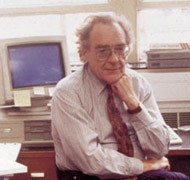 Maddox returned for his second stint as editor in 1980. This was not universally popular with employees of the more organized Dai Davies culture. However, Davies was considered too academic by some, and the return of Maddox’s journalistic zeal and love of print was welcomed. Maddox (pictured) did not share his thoughts with readers in a Nature editorial on his return. Instead, in an article called ‘Back to Nature’ in the in-house Macmillan News, he candidly explored what had changed in the seven years since he had abruptly left the post: “Nature is now more highly organised than in the old days ... it has to be ... the field in which we make our living has become even more competitive.” A nod, perhaps, to the accomplishments of Davies, who had turned out to be both his successor and his predecessor. Nature, Maddox said, was approaching not one, “but half a dozen turning points”. And it hadn’t all changed, as he wryly noted: “one of the locks on the men’s loo on the third floor still doesn’t work”.
Maddox returned for his second stint as editor in 1980. This was not universally popular with employees of the more organized Dai Davies culture. However, Davies was considered too academic by some, and the return of Maddox’s journalistic zeal and love of print was welcomed. Maddox (pictured) did not share his thoughts with readers in a Nature editorial on his return. Instead, in an article called ‘Back to Nature’ in the in-house Macmillan News, he candidly explored what had changed in the seven years since he had abruptly left the post: “Nature is now more highly organised than in the old days ... it has to be ... the field in which we make our living has become even more competitive.” A nod, perhaps, to the accomplishments of Davies, who had turned out to be both his successor and his predecessor. Nature, Maddox said, was approaching not one, “but half a dozen turning points”. And it hadn’t all changed, as he wryly noted: “one of the locks on the men’s loo on the third floor still doesn’t work”.
That year, Nature made its first foray into electronic publishing, with a news story on the UK Post Office’s videotex system, Prestel, which displayed articles on television sets hooked up to phone lines.
The early 1980s saw the launch of Nature’s first successful sister journal, after the doomed attempt of the 1970s. Bio/technology (now Nature Biotechnology) marked the beginning of a new era in publishing that would see a string of journals created under the Nature brand.
Maddox visited Japan in 1983 for a special issue on science in the country. The mid-to-late 1980s saw Nature establish a foothold in the region: Alun Anderson, who would later become editor-in-chief of the magazine New Scientist, was Nature’s first correspondent in Japan.
The discovery of the ‘hole’ in Earth’s ozone layer over Antarctica provided evidence to scientists, politicians and the public that human activity could modify the global environment within just a couple of generations. Published in Nature in 1974, work by Mario Molina and F. Sherwood Rowland had established that chlorine originating from chlorofluorocarbons (CFCs) was an agent of ozone destruction; for this, they received a share of the 1995 Nobel Prize in Chemistry. But the finding was just the start of the story. In May 1985, Joe Farman and his colleagues at the British Antarctic Survey reported that spring ozone levels over Antarctica were much lower than expected. The authors correctly predicted that CFCs were responsible, although the chemical mechanism that they proposed was wrong. Satellite data published in 1986 confirmed the Antarctic group’s findings, and a flurry of papers that followed, by Susan Solomon, Paul Crutzen, Michael McElroy and their colleagues, set out the chemical basis of the phenomenon.
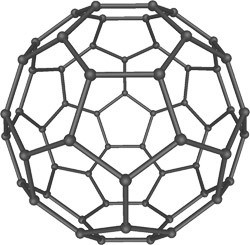 Pure carbon was thought to exist in only two forms — diamond and graphite — until the 1985 emergence of C60 (pictured) showed just how beautiful chemistry can be. Like many discoveries, it came about more by accident than design, when Harold Kroto and his colleagues were vaporizing graphite in the hope of creating the molecules thought to inhabit interstellar space. Naturally occurring C60 has since been found in soot, carbonaceous meteorites and the mineral shungite. Its spherical structure is made up of a mixture of tessellating pentagons and hexagons — just like a football. C60 also resembles the geodesic domes of US inventor and architect Buckminster Fuller, and so was soon nicknamed buckminsterfullerene. Carbon can also take other forms known as fullerenes, which include carbon nanotubes, and molecules in this family can be made to superconduct. The arrival of fullerenes (and an easy method of synthesis) revolutionized materials science and marked its maturation into a distinct and modern discipline.
Pure carbon was thought to exist in only two forms — diamond and graphite — until the 1985 emergence of C60 (pictured) showed just how beautiful chemistry can be. Like many discoveries, it came about more by accident than design, when Harold Kroto and his colleagues were vaporizing graphite in the hope of creating the molecules thought to inhabit interstellar space. Naturally occurring C60 has since been found in soot, carbonaceous meteorites and the mineral shungite. Its spherical structure is made up of a mixture of tessellating pentagons and hexagons — just like a football. C60 also resembles the geodesic domes of US inventor and architect Buckminster Fuller, and so was soon nicknamed buckminsterfullerene. Carbon can also take other forms known as fullerenes, which include carbon nanotubes, and molecules in this family can be made to superconduct. The arrival of fullerenes (and an easy method of synthesis) revolutionized materials science and marked its maturation into a distinct and modern discipline.
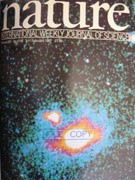 By the 1980s, Nature had more or less reached its modern form, but there was still room for additions. Shortly into the second Maddox era, Matters Arising appeared; it tackled scientific correspondence regarding specific papers, rather than generic issues relating to science. Also debuting in the 1980s were New on the Market, a summary of new commercial research products, and Employment, a one-page essay that can be seen as a very early forerunner to Nature’s Careers section. A 1986 supplement reporting the first results from five spacecraft to probe Halley’s comet unhelpfully coincided with the first papers on the fallout from the Chernobyl nuclear accident in Ukraine, ensuring a working week as close to the wire as any before. As in the 1970s, editorials continued to look closely and frequently at arms control, nuclear weapons and the mooted ‘Star Wars’ defence system. And more attention was paid to economics: an editorial welcoming 1981 declared boldly: “Economic problems matter because they determine the resources available for ... institutions and for innovation”. A cover from the 1980s is pictured.
By the 1980s, Nature had more or less reached its modern form, but there was still room for additions. Shortly into the second Maddox era, Matters Arising appeared; it tackled scientific correspondence regarding specific papers, rather than generic issues relating to science. Also debuting in the 1980s were New on the Market, a summary of new commercial research products, and Employment, a one-page essay that can be seen as a very early forerunner to Nature’s Careers section. A 1986 supplement reporting the first results from five spacecraft to probe Halley’s comet unhelpfully coincided with the first papers on the fallout from the Chernobyl nuclear accident in Ukraine, ensuring a working week as close to the wire as any before. As in the 1970s, editorials continued to look closely and frequently at arms control, nuclear weapons and the mooted ‘Star Wars’ defence system. And more attention was paid to economics: an editorial welcoming 1981 declared boldly: “Economic problems matter because they determine the resources available for ... institutions and for innovation”. A cover from the 1980s is pictured.
In 1988, an agreement was reached with China’s national science and technology agency, which had previously supported the piracy of Nature in the country, to publish an English-language edition in China. The same year saw a deal hatched with Yuri Kanin, then chief science commentator for the Russian Novosti Press Agency, which would see three Soviet scientists contributing to one substantial article every two weeks (four articles were sent in the first week, much to Maddox’s embarrassment). Closer to home, Nature was asked by The Times to relaunch the newspaper’s daily Science Report column. The first proposal for Nature to provide science columns for The Times dates back to around 1878, when Norman Lockyer was editor.
The 1980s saw Nature expanding its global operations, establishing a string of offices around the world. The 1980 opening of the New York City office in the iconic Flatiron Building on Fifth Avenue was accompanied by a marketing trial that saw 50,000 free copies sent to institutions across the United States; a larger campaign that followed is credited with boosting subscriptions by 3,988 in just one year. This helped Nature’s circulation in the United States and Canada to breach the 10,000 mark by 1981, and by 1984 the New York office had 19 staff members and US circulation stood at 12,300. By the end of the decade, Nature had correspondents in Boston, San Francisco, New Delhi, Paris and Melbourne, in addition to its offices in London, Washington DC, New York and Tokyo — a global presence to match the worldwide perspective that Nature has always retained.
1990s
The 1990s saw a period of rapid change and development for Nature at home and abroad. E-mail and electronic systems were used for the first time to manage manuscripts, and Nature’s first website was set up. The international expansion continued, with the founding in 1996 of Nature’s first office in Australia; the journal’s first conference in South Korea was organized the following year. Nature’s Russian bureau opened in 1993 and distributed a monthly edition, published in the country, until 1997: it had 128 black-and-white pages and a circulation of 3,500 at its peak. Photocopies were freely available and many complaints were received when the edition was discontinued. Cooperation with Russia also included a special issue of the science magazine Priroda, which contained a selection of classic Nature papers. Nature’s operations were sufficiently internationalized for a large-scale move to New York to be proposed in 1996, but the idea was abandoned.
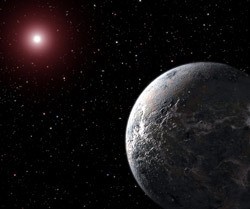 Could life exist on other planets in galaxies far, far way? Extraterrestrials need homes too, and the hunt for planets outside our Solar System — extrasolar planets, or exoplanets — has been on since at least the 1940s. In 1992, Aleksander Wolszczan and Dale Frail obtained the first confirmed finding: two small planets orbiting a pulsar. These were pinpointed by measuring changes in the movement of the parent star (indicated by the Doppler shift in its radio emissions) caused by the gravitational effects of the orbiting bodies. It was not until 1995 that Michael Mayor and Didier Queloz of the Geneva Observatory, Switzerland, found 51 Pegasi b (artist’s impression pictured), a Jupiter-sized planet orbiting a Sun-like star, which could be a better bet for finding evidence of life. The gravitational tug of the planet on the parent star revealed its orbit to be extremely close (one-seventh of the distance from Mercury to the Sun) and swift (a ‘year’ in just four Earth days). Nearly 4,000 exoplanets have since been found. Image: NASA/ESA/G. Bacon (STScI).
Could life exist on other planets in galaxies far, far way? Extraterrestrials need homes too, and the hunt for planets outside our Solar System — extrasolar planets, or exoplanets — has been on since at least the 1940s. In 1992, Aleksander Wolszczan and Dale Frail obtained the first confirmed finding: two small planets orbiting a pulsar. These were pinpointed by measuring changes in the movement of the parent star (indicated by the Doppler shift in its radio emissions) caused by the gravitational effects of the orbiting bodies. It was not until 1995 that Michael Mayor and Didier Queloz of the Geneva Observatory, Switzerland, found 51 Pegasi b (artist’s impression pictured), a Jupiter-sized planet orbiting a Sun-like star, which could be a better bet for finding evidence of life. The gravitational tug of the planet on the parent star revealed its orbit to be extremely close (one-seventh of the distance from Mercury to the Sun) and swift (a ‘year’ in just four Earth days). Nearly 4,000 exoplanets have since been found. Image: NASA/ESA/G. Bacon (STScI).
Nature built on its previous wave of international expansion by publishing a series of supplements focusing on scientific and technological developments in other countries. The fall of the Berlin Wall in 1989 opened up the old Eastern Bloc faster than many had anticipated, and the 1990 supplement Science in Eastern Europe was quick to examine opportunities there. Science in Japan (1992) asked what kind of research reforms were needed in the country; and the 1995 Science in China supplement dissected the communist state’s ambitious five-year development plan. In the same year, Science in Australia (1995) looked at the radio telescopes of the outback and concluded that “Australian science is in good shape”. The 1990s also saw the introduction of ‘How to get published in Nature’ guides in Japanese (1994) and Chinese (1998), among other languages, to encourage submissions.
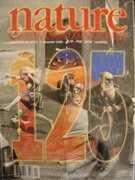 “The scientific enterprise has had a marvellous century”, was the bold opening gambit for ‘How to mark 125 years of discovery’, the introductory article of the Frontiers of Ignorance special that marked Nature’s anniversary edition in 1994 — the magazine’s 6,501st issue (pictured). After candidly asserting that “Nature became a scientific journal only by accident”, the issue mostly looked forward, rather than back: it contained a series of News & Views pieces and ‘Questions yet unanswered’ on the big problems (mostly in physics) still facing science: will the Universe expand indefinitely, or stop? How did life begin? Is the brain a computer? With DNA deciphered, and silicon chips now found in every office, ‘The endless frontier’ asked “what further discoveries of importance can there be?” while also reminding readers about the periodic scientific revolutions, such as that of the quantum world versus Newtonian mechanics, that have always lain in wait to transform our view of the Universe.
“The scientific enterprise has had a marvellous century”, was the bold opening gambit for ‘How to mark 125 years of discovery’, the introductory article of the Frontiers of Ignorance special that marked Nature’s anniversary edition in 1994 — the magazine’s 6,501st issue (pictured). After candidly asserting that “Nature became a scientific journal only by accident”, the issue mostly looked forward, rather than back: it contained a series of News & Views pieces and ‘Questions yet unanswered’ on the big problems (mostly in physics) still facing science: will the Universe expand indefinitely, or stop? How did life begin? Is the brain a computer? With DNA deciphered, and silicon chips now found in every office, ‘The endless frontier’ asked “what further discoveries of importance can there be?” while also reminding readers about the periodic scientific revolutions, such as that of the quantum world versus Newtonian mechanics, that have always lain in wait to transform our view of the Universe.
 A year after the 125th anniversary issue, the Maddox era came to a close with the appointment of Nature’s former physical sciences editor Philip Campbell (pictured) as the editor of Nature — only the eighth person to hold the post. Maddox’s closing editorial, ‘Valediction from an old hand’ is a subtle blend of anecdote and reason, tackling issues such as the (occasional) place for an unrefereed paper, the confidentiality of the refereeing system, scientific misconduct and the sometimes impenetrable use of English in the communication of science, asking whether “people hide their meaning from insecurity”. Campbell’s first editorial, ‘Postscript from a new hand’, took note of Maddox’s comments and promised that “resources are being invested in further enhancing the readability of what we produce”, before assuring readers that Nature would “continue to pursue scientific excellence and journalistic impact with vigorous independence”. Maddox was knighted in 1996 for services to science, and the retrospective book A Bedside Nature, edited by biochemistry correspondent Walter Gratzer, was published that year.
A year after the 125th anniversary issue, the Maddox era came to a close with the appointment of Nature’s former physical sciences editor Philip Campbell (pictured) as the editor of Nature — only the eighth person to hold the post. Maddox’s closing editorial, ‘Valediction from an old hand’ is a subtle blend of anecdote and reason, tackling issues such as the (occasional) place for an unrefereed paper, the confidentiality of the refereeing system, scientific misconduct and the sometimes impenetrable use of English in the communication of science, asking whether “people hide their meaning from insecurity”. Campbell’s first editorial, ‘Postscript from a new hand’, took note of Maddox’s comments and promised that “resources are being invested in further enhancing the readability of what we produce”, before assuring readers that Nature would “continue to pursue scientific excellence and journalistic impact with vigorous independence”. Maddox was knighted in 1996 for services to science, and the retrospective book A Bedside Nature, edited by biochemistry correspondent Walter Gratzer, was published that year.
From 1995, Nature — although still part of Macmillan Publishers — was for the first time in its history not wholly owned by the actual Macmillan family (or the ‘House of Macmillan’). In June, the German-based, family-run company Verlagsgruppe Georg von Holtzbrinck acquired a 71% stake in the publishers, a move that meant that Nature was now owned by a foreign company (Holtzbrinck completed purchase of Macmillan in 1999). That the company was private and not listed on the stock exchange was a comfort for some: there were no shareholders to please. As the parent company moved in 1995, so did the Nature offices — relocating across London, from Little Essex Street to Crinan Street in King’s Cross.
The 1990s saw many internal and external publishing activities at Nature go electronic. In 1988, 6,000 papers were submitted and 1,000 published — that’s around 25 papers received every working day. To cope with the increasing volume of submissions, including those from journal launches, in 1990 an electronic system was introduced to track the progress of manuscripts from submission to publication. E-mail arrived in the offices in 1995. Public-facing electronic ventures included the first CD-ROM archives, released in 1995, and November that same year saw Nature's first presence on the World Wide Web as www.nature.com. A daily news service, Nature Science Updates, started at same time, and in 1998 nature.com was relaunched, with full-text articles made available electronically. Nature’s first press site was set up in 1999 to help journalists and promote public relations.
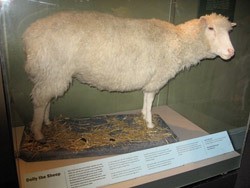 Dolly (pictured) became probably the most famous lamb in the world and provoked strong reactions from scientists, politicians and the public alike when she was revealed to the world by Ian Wilmut of the Roslin Institute, Edinburgh, on 22 February 1997. She showed that mammals — familiar, cuddly ones that were bigger than small children — could be cloned and, surely, if you can clone a sheep, you can clone a person? Behind the headlines, however, Dolly was not the first cloned mammal: Steen Willadsen reported the first, also a sheep, in 1986. The cloning technique of nuclear transfer was first used in mice in 1983, although it took the original cells from embryos and produced no living animal. Advances in using nuclei from cells in culture led to cloned calf embryos in 1994, and then the real breakthrough came when Wilmut’s group achieved nuclear transfer from an established cell line in 1996. Dolly’s uniqueness was that she was cloned from an adult cell, so overriding the potential moral and ethical baggage attached to using (and destroying) early embryos. The myriad possible medical implications are only just being realized.
Dolly (pictured) became probably the most famous lamb in the world and provoked strong reactions from scientists, politicians and the public alike when she was revealed to the world by Ian Wilmut of the Roslin Institute, Edinburgh, on 22 February 1997. She showed that mammals — familiar, cuddly ones that were bigger than small children — could be cloned and, surely, if you can clone a sheep, you can clone a person? Behind the headlines, however, Dolly was not the first cloned mammal: Steen Willadsen reported the first, also a sheep, in 1986. The cloning technique of nuclear transfer was first used in mice in 1983, although it took the original cells from embryos and produced no living animal. Advances in using nuclei from cells in culture led to cloned calf embryos in 1994, and then the real breakthrough came when Wilmut’s group achieved nuclear transfer from an established cell line in 1996. Dolly’s uniqueness was that she was cloned from an adult cell, so overriding the potential moral and ethical baggage attached to using (and destroying) early embryos. The myriad possible medical implications are only just being realized.
The magazine had by now reached its modern format, save for a couple of additions, such as Futures — a series of science fiction (or speculative fiction) short stories intended to let writers “express not their predictions but their preoccupations with the present day”. Supplements continued on an ad hoc basis, covering topics such as immunology, allergies, science in Latin America and careers. Scientific discoveries continued apace from all fields, including Australopithecus ramidus (now Ardipithecus ramidus), at the time the the oldest known hominin, in 1994, and, in 1998, an Indonesian population of the coelacanth fish, once considered extinct. In 1994, the total synthesis of taxol was a significant step towards producing anticancer drugs, and a gene called obese was cloned. There were also reports of quantum teleportation in 1997 and gravitational lensing — a key test of relativity theory — in 1993, as well as the synthesis of carbon nanotubes in 1991, polymer LEDs in 1990 and artificial diamonds in 1993.
The 1990s saw the launch of specialist sister journals to Nature. These covered a wide range of scientific disciplines, starting with Nature Genetics in 1992, followed by Nature Structural Biology (now Nature Structural & Molecular Biology) in 1994, Nature Medicine in 1995, Nature Biotechnology in 1996 (relaunched from Bio/technology), Nature Neuroscience in 1998 and Nature Cell Biology in 1999. These soon became distinct entities, with some, such as Nature Genetics, becoming competitors with Nature because they could offer authors more space. To accommodate the burgeoning stock of publications, 1999 saw the birth of Nature Publishing Group from the merging of Stockton Press, publisher of more specialist academic journals such as Oncogene, with Macmillan Magazines, publisher of Nature and its sister titles.
2000s
Nature celebrated the new millennium by taking an active role in the British Association for the Advancement of Science’s millennial events, including a collaboration with the Royal Society on More than Meets the Eye, a programme of science and art performances, talks and events at the Victoria and Albert Museum in London. The 2000s saw a proliferation of Nature-branded journals, and many discoveries, especially in the sequencing of genomes. As access to fast Internet connections became more widely available, Nature explored the future of computing and its effects on how science is conducted. With the information age well under way, the ramifications for science were explored in pieces such as ‘Machine readability’, ‘Publishing on the semantic web’ and ‘Science in the web age: Joint efforts’.
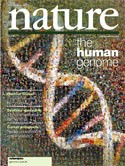 The Human Genome Project was formally launched in 1990 and scientists from the United States, United Kingdom, France, Germany, China and Japan formed the International Human Genome Sequencing Consortium to complete the work at centres around the world. A special issue (pictured) of Nature on 15 February 2001 published the draft human genome. At the same time, the journal Science reported the sequencing of the human genome by the privately funded Celera Genomics, which from 1998 onwards used the ‘whole genome shotgun sequencing’ technique on DNA — some of the samples coming from the company’s founder, Craig Venter. The final, final draft of the human genome was completed in 2006, when the sequence of the last chromosome was published, and Nature celebrated with a special Human Genome Collection supplement and produced a video to mark the event. Nature has also published genome sequences of the opossum (Monodelphis domestica), honeybee (Apis mellifera) and chimpanzee (Pan troglodytes), among others.
The Human Genome Project was formally launched in 1990 and scientists from the United States, United Kingdom, France, Germany, China and Japan formed the International Human Genome Sequencing Consortium to complete the work at centres around the world. A special issue (pictured) of Nature on 15 February 2001 published the draft human genome. At the same time, the journal Science reported the sequencing of the human genome by the privately funded Celera Genomics, which from 1998 onwards used the ‘whole genome shotgun sequencing’ technique on DNA — some of the samples coming from the company’s founder, Craig Venter. The final, final draft of the human genome was completed in 2006, when the sequence of the last chromosome was published, and Nature celebrated with a special Human Genome Collection supplement and produced a video to mark the event. Nature has also published genome sequences of the opossum (Monodelphis domestica), honeybee (Apis mellifera) and chimpanzee (Pan troglodytes), among others.
 A permanent tribute to Norman Lockyer was unveiled in January 2003 at the house on Penywern Road in Earl’s Court, London, where Lockyer lived from 1876 to 1920. English Heritage, which aims to protect and promote England’s historic environment, awards blue plaques to people with a strong reputation who have gained recognition through their life and work. The plaque (pictured) was unveiled by then-science minister David Sainsbury, who in his speech said that Lockyer “is, of course, known to us for establishing the world-renowned scientific journal Nature and also for discovering the element helium. He also played an important role in raising the standards of science education in the country, and helped to found both Imperial College and the Science Museum.”
A permanent tribute to Norman Lockyer was unveiled in January 2003 at the house on Penywern Road in Earl’s Court, London, where Lockyer lived from 1876 to 1920. English Heritage, which aims to protect and promote England’s historic environment, awards blue plaques to people with a strong reputation who have gained recognition through their life and work. The plaque (pictured) was unveiled by then-science minister David Sainsbury, who in his speech said that Lockyer “is, of course, known to us for establishing the world-renowned scientific journal Nature and also for discovering the element helium. He also played an important role in raising the standards of science education in the country, and helped to found both Imperial College and the Science Museum.”
Important scientific news has always been central to the Nature publishing philosophy, and 2004 saw the launch of news@nature.com, a specialized service for publishing in-depth news daily on the web, rather than just weekly in print. Replacing the 1990s Nature Science Updates, the site had an independent subscription service to cater for an audience that would be less concerned with reading primary research. It made an immediate impact and scooped the 2004 Association of British Science Writers award for the best science writing on the Internet for the Flores man special (see below). The redesigned Nature News website launched in late 2007.
The announcement of the discovery of Homo floresiensis, an extinct and previously undescribed species of hominin, on the Indonesian island Flores caused a worldwide sensation, although the evidence that a cousin of humanity might have been living in isolation until just tens of thousands of years ago didn’t convince everyone. With the discovery coming on the back of the release of the Lord of the Rings films, the small stature of H. floresiensis meant that the species was soon dubbed ‘hobbits’; public imagination was fired further by legends of mischievous humanoid forest-dwellers that had been seen by locals on Flores just hundreds of years ago. The finding even inspired British artist Damien Hirst to paint a picture of the hobbit’s skull next to a modern human skull. See the Flores man special and web focus for more.
For more than 125 years, Nature had been solely a print publication, but the arrival of the Internet brought new media platforms and opportunities to experiment. By 2004, podcast had become a buzzword and many publishers were keen to jump on the bandwagon. Audio files had been available on the web for some time, but the provision of web feeds such as RSS meant that users could subscribe and never miss an episode of their favourite show. In 2005, Nature enlisted the Naked Scientists, a Cambridge-based group of science-media enthusiasts, to help produce the Nature Podcast, which would highlight news and discoveries of the week by interviewing scientists and Nature editors. It was an immediate success and led to Nature Publishing Group (NPG) producing other podcasts.
If 2005 was the year of the podcast, 2006 was the year of Internet video and other web innovations. Nature took an early interest in video, and from late 2005 began working with producers to make pieces to accompany major papers. The Nature Video archive now features many scientists describing their work in their own words, from the invention of an ion-drive plane and the discovery of prehistoric cave art to the development of the computer that mastered the game Go. Another novelty for 2006 was a Google Earth mashup file, developed by Nature’s news reporter Declan Butler, which tracked outbreaks of the H5N1 avian-influenza virus in animals and humans around the globe. This won the Association of Online Publishers 2006 award for best use of a new digital platform.
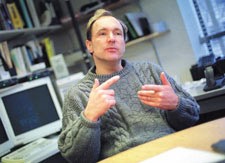 The term ‘Web 2.0’ came to signify the next step of the Internet — communities using social networking to discover and share information. Nature quickly recognized that science communication lends itself to networking, the World Wide Web itself having been invented at the CERN particle-physics laboratory near Geneva, Switzerland, by computer scientist Tim Berners-Lee (pictured; see also his Commentary on the semantic web). After hosting a debate on open access in 2004, Nature experimented with open peer review in 2006 and invited discussion on the topic. Nature’s news site also embraced the vogue for user forums and blogs with the Nature Newsblog, which allowed readers to comment on stories. Other NPG blogs catered for specific scientific communities. NPG also developed Web 2.0 applications such as Connotea, which scientists could use to save, tag and share their favourite Internet pages. NPG’s position as a pioneer in progressive publishing practices was further enhanced when it co-hosted the conference Science Foo Camp 2006 — a freeform talkfest of writers, scientists and technologists — at the Googleplex, Google’s headquarters in Mountain View, California. It became an annual event.
The term ‘Web 2.0’ came to signify the next step of the Internet — communities using social networking to discover and share information. Nature quickly recognized that science communication lends itself to networking, the World Wide Web itself having been invented at the CERN particle-physics laboratory near Geneva, Switzerland, by computer scientist Tim Berners-Lee (pictured; see also his Commentary on the semantic web). After hosting a debate on open access in 2004, Nature experimented with open peer review in 2006 and invited discussion on the topic. Nature’s news site also embraced the vogue for user forums and blogs with the Nature Newsblog, which allowed readers to comment on stories. Other NPG blogs catered for specific scientific communities. NPG also developed Web 2.0 applications such as Connotea, which scientists could use to save, tag and share their favourite Internet pages. NPG’s position as a pioneer in progressive publishing practices was further enhanced when it co-hosted the conference Science Foo Camp 2006 — a freeform talkfest of writers, scientists and technologists — at the Googleplex, Google’s headquarters in Mountain View, California. It became an annual event.
In September 2010, Nature New Biology and Nature Physical Science, which were published in addition to the main journal from 1971 to 1973, were made available online.
2010s
From 2010, the Nature group of journals and Nature itself became increasingly engaged with multidisciplinary research themes and societal challenges. In 2010, Nature published the first in a series of supplements and collections on mental-health research, with a special issue on schizophrenia. Over subsequent years, both the magazine and journal sections repeatedly covered mental health, as a subject of research and as an increasingly recognized challenge in the research community.
In that broader spirit, in 2011 Nature’s publishers launched Nature Climate Change. This was the first of the Nature research journals devoted to a theme rather than a discipline, and it was staffed by a multidisciplinary team of editors, including social scientists. Since then, continuing to cater for research that relates to challenges facing humanity, the publishers have launched Nature Energy (2016), Nature Human Behaviour (2017) and Nature Sustainability (2018). Nature itself increased its attention to such challenges, partly in research papers and more systematically in its magazine sections. The publication also increased its focus on applied science, accompanied by the new journals Nature Biomedical Engineering (2017), Nature Electronics (2018) and Nature Catalysis (2018).
At the same time, the decade saw some strong emerging themes in more conventional disciplinary science. In astronomy, the sheer variety of planets known to orbit stars other than the Sun grew and grew, and such a planet was even found close to home. Research in Nature’s pages about two-dimensional materials built on the previous decade’s discovery of the extraordinary properties of graphene, and interest in solid materials with properties governed by the hidden topology of electron behaviours grew substantially. On the applied front, this was a great age for research on perovskite photovoltaics.
Perhaps more spectacular were papers in the life sciences and in machine intelligence: for example, one described the complete mitochondrial genome of an unknown hominin from southern Siberia, the first DNA from Denisovans. Another explained how artificial intelligence based on deep neural networks had mastered the game of Go. More broadly, the flowering of the ‘omes’ approach to the life sciences was well reflected with descriptions of the human microbiome, the 1000 Genomes Project, sequencing of cancer genomes and ENCODE, an encyclopaedia of human DNA elements. The power of stem-cell research was demonstrated with the conversion of animal and human cells called fibroblasts into neurons, and the ability to grow organoids from human stem cells.
The early 2010s saw Nature’s magazine component, which had grown substantially in the previous decade, consolidate its strength. By 2010, the magazine was under the oversight of a chief magazine editor, and delivered a regular weekly package of news, in-depth reporting, comment, life in the lab and the weekly one-page science-fiction story in the Futures section. On top of this, the daily package of online news grew. In 2018, the publishers launched Nature Briefing — a free daily and weekly round-up of ‘hot’ items culled from many sources.
The decade also saw a number of editorial campaigns in Nature’s magazine sections relating to the practice of research. One was about the challenges of irreproducibility, especially in the life sciences, and was backed by editorial policies applied in the journal section. Nature led the way in science publishing with its 2013 introduction of a reporting checklist for authors, and in its commissioning of many opinionated articles about various aspects of the problem.
The magazine also explored the culture of research, including running surveys and holding workshops with early-career researchers and lab leaders. This effort led to a special issue about developing and sustaining research groups that are (in the most general sense) ‘healthy’.
Often described as the world’s leading science journal, Nature was conscious of the growing movement to reduce over-dependence on its brand as a surrogate for personal achievement in the assessment of individual researchers — a movement that the publication’s editors fully endorsed from its early days. At the same time, Nature faced the business challenge of adapting to funders’ gradually growing insistence that their grant recipients publish results in a way that makes them fully and freely accessible to all from the moment of publication.
In 2018, Magdalena Skipper was appointed as the first female editor-in-chief of Nature. Dr Skipper – a geneticist with a PhD from the University of Cambridge - spent over 15 years working for Nature Publishing Group, first joining in 2001. She held a range of roles: Chief Editor of Nature Reviews Genetics; Senior Editor for genetics and genomics and Team Leader, Nature; Executive Editor of the Nature Partner Journals and Editor in Chief, Nature Communications.
At Nature, she was instrumental in the developing the innovative ENCODE Explorer and Epigenome Roadmap projects, which pushed the boundaries of science publishing beyond the conventional research paper. In 2018, she was a co-founder of Nature Research Awards for Inspiring and Innovating Science which aim to promote women in science.
